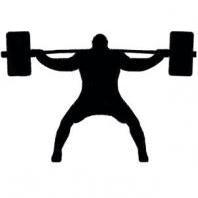Líderes
Conteúdo Popular
Exibindo conteúdo com a maior reputação em 06/02/2016 em todas áreas
-
5 pontos
-
5 pontos
-
4 pontos
-
Por sugestão do grande @Shrödinger: Fonte: http://bretcontreras.com/training-for-maximum-muscle-growth-explained Explicando treinos para maximizar o crescimento muscular Todos queremos músculos maiores e para construí-los, precisamos nos tornar mais fortes - muito mais fortes. O ganho de força pela progressão de cargas garante que continuamos a colocar mais tensão nos músculos ao longo do tempo, forçando-os a se adaptar por meio do seu crescimento. Cargas mais pesadas equivalem a maior tensão, que equivale a músculos maiores. Entendido? Ótimo! No entanto, cargas maiores sozinhas não vão construir os maiores músculos. Powerlifters levantam cargas maiores do que bodybuilders e assim, colocam mais tensão em suas musculaturas se comparados aos bodybuilders. Apesar desta tensão mais alta, bodybuilders ainda são maiores. Se tensão fosse a verdade suprema, os músculos dos powerlifters superariam os dos bodybuilders. Não podemos dizer que são só as drogas. Pense nisso - ambos os tipos de atleta tomam esteroides anabolizantes, bodybuilders naturais ainda são maiores que powerlifters naturais e quando powerlifters desejam construir mais músculo, eles emprestam dos bodybuilders a metodologia de utilizar exercícios acessórios com repetições mais altas e com tempo menor de descanso entre as séries. Há alguns anos, meu colega Brad Schoenfeld e eu escrevemos um artigo abrangente, descrevendo os mecanismos na qual bodybuilders são mais musculosos que powerlifters. O artigo recebeu o título "Porque Bodybuilders são maiores que Powerlifters", e se você ainda não o leu, recomendo que o faça. No presente artigo, gostaria de desenvolver este tema. No lendário artigo de Brad "Os Mecanismos da Hipertrofia Muscular", ele nos ensina que existem três tipos principais de hipertrofia: 1. Tensão mecânica 2. Estresse metabólico 3. Dano muscular Para muitos atletas, estes mecanismos fazem sentido à medida que correspondem à sua experiência pessoal. Porém, para muitos outros atletas, esta lista é meio abstrata e nebulosa. Permita-se explicar estes mecanismos de forma simples e direta. Tensão mecânica Às vezes você pode sentir que um músculo está prestes a rasgar do osso ao trabalhar com cargas pesadas. Isso, meu amigo, é tensão mecânica. Se você coloca tensão em um músculo por esticá-lo passivamente (sem deixar que ele contraia), a origem desta tensão é chamada de tensão elástica passiva. Se você coloca tensão em um músculo por flexioná-lo o máximo possível via contração isométrica, a origem desta tensão é chamada de tensão ativa. Quando você move pesos usando amplitude máxima, os músculos são expostos a uma combinação de tensão passiva e ativa, já que eles são esticados enquanto estão sendo ativados. Pesquisas mostram que movimentos dinâmicos são superiores a tanto esticar quanto usar isometria para ganhos de hipertrofia, então a tensão sozinha não trará o maior crescimento muscular. Tensão por meio de amplitude máxima de movimento é o que constrói os maiores músculos. Além disso, o tempo sob tensão (TUT - time under tension) é um outro fator importante a se considerar. Executar uma contração máxima 1 vez a cada 2 semanas não produzirá ganhos máximos de hipertrofia - não será estímulo suficiente para otimizar os processos anabólicos. Os músculos precisam de ampla sinalização para crescer. Estresse metabólico Pense na sensação que você tem ao saber que está realmente focando em um músculo - a sensação de queimação que você obtém e o pump que você atinge. Esses são dois mecanismos que caem no guarda-chuva do estresse metabólico. O estresse metabólico é causado por vários fatores, incluindo: 1. A oclusão de veias por meio de contrações musculares contínuas, o que previne o sangue de escapar; 2. A hipóxia ou falta de aporte de oxigênio nos músculos devido ao aprisionamento do sangue; 3. O desenvolvimento de subprodutos metabólicos, como lactato e aumento da atividade hormonal; 4. O inchaço das células ou pump dos músculos, também devido ao sangue aprisionado. Esses fatores ajudam a construir músculo e são sinérgicos com tensão e progressão de carga. Esses fatores também ajudam a explicar porque treinos Kaatsu (oclusão vascular) é altamente efetivo para produzir hipertrofia, embora com níveis mais baixos de tensão muscular se comparados a treinos de resistência tradicionais. Dano muscular Aproximadamente dois dias após um treino extenuante, sua dor muscular provavelmente atingirá o auge, e essa dor até é um certo indicativo de lesão muscular. O dano é criado ou por fazer algo que não está acostumado, por acentuar o componente excêntrico de um exercício ou por estender um músculo enquanto ele está sendo ativado, causando assim altos graus de desgaste. Desta maneira, a variedade é um componente importante no dano muscular, já que ela garante focar em diferentes subdivisões e unidades motoras dos músculos. A inter-relação entre Tensão, Estresse metabólico e Dano muscular Esse trecho será um pouco técnico, mas fique comigo. Tensão mecânica, estresse metabólico e dano muscular são inter-relacionados e geram respostas hipertróficas por caminhos diversos e redundantes. Por exemplo, um grau elevado de tensão ativa em músculos mais longos cria o maior dano muscular. Em outras palavras, a tensão é muito efetiva para danificar fibras contanto que o músculo seja estendido enquanto esta sendo ativado. Um outro exemplo: alta tensão através de ROM completo é muito efetiva para produzir estresse metabólico devido às contrações musculares prolongadas, causando oclusão das veias e deixando o sangue sem tempo de escapar dos músculos. Em outras palavras, tensão constante e TUT maior são muito efetivos para causar estresse metabólico, presumindo que a ativação muscular é alta o suficiente para ocluir as veias. Continuando com os exemplos, o pump realmente coloca os miócitos sob tensão devido ao efeito de inchaço exercido nas membranas das células musculares, o que teoricamente leva a um maior crescimento muscular dada a uma ameaça detectada às ultraestruturas das células. Em outras palavras, o estresse metabólico é eficiente para criar tensão de dentro para fora nas células musculares individuais. Na realidade, dano às fibras pode provocar inchaço das células da mesma maneira que o pump, e este inchaço pode durar por vários dias. Todos os três mecanismos podem aumentar a ativação de células satélite (células-tronco musculares) assim como a ativação do importante caminho mTOR. Como você pode ver, os três mecanismos estão altamente inter-relacionados. Aplicações práticas Muitos treinadores argumentam que a progressão de cargas com treinos de baixas repetições nos exercícios básicos com barra é suficiente para construir a hipertrofia máxima. O motivo pelo qual esta afirmação é tão eficaz está em muitas pessoas não compreenderem totalmente a importância de ganhar força em relação ao crescimento muscular. Porém, isso sozinho não é suficiente para ganhos máximos. Como Brad e eu detalhamos em nosso artigo anterior, há muitos mecanismos neurais (não-hipertróficos) no qual um músculo pode se fortalecer sem crescer. Esse é um lado chave no powerlifting, onde atletas aprendem a maximizar a força pelos ganhos de eficiência do sistema nervoso e coordenação. Se seu objetivo é construir o máximo de músculos, você simplesmente não vai querer depender somente em melhorias neurais para ganho de força; você quer que seus ganhos de hipertrofia imitem seus ganhos de força. Portanto, tenha certeza de alternar exercícios, incorporar variedade e se tornar forte em faixas de repetição baixas, médias e altas. Escolhendo as ferramentas certas Alguns exercícios são melhores que outros para produzir pump, alguns exercícios são melhores que outros para criar tensão em um músculo ou subdivisão de um músculo, e alguns exercícios são melhores que outros para danificar fibras. Em geral, fazer agachamento, levantamento terra, elevação pélvica (hip thrusts), supino, desenvolvimento militar, chin-up e remada vai garantir que você está maximizando a tensão mecânica em todos os grupos musculares. Porém, somente um exercício não vai maximizar a tensão na gama completa de fibras dentro de um músculo. Exercícios como supino inclinado, paralelas, roscas, encolhimento, crucifixo invertido (delt raises), leg press e glute ham raises podem e devem também ser utilizados para o máximo crescimento muscular, já que eles focam em fibras específicas se comparados com os exercícios compostos. Além disso, variações dos exercícios compostos como agachamento frontal, levantamento terra sumô, supino fechado e pull-up também podem e devem ser feitos. Movimentos que colocam tensão constante ou colocam tensão máxima em um músculo mais curto (em posição contraída) são os melhores para construir pump. Por isso, exercícios como pec deck, pullover na máquina, extensão de pernas, flexão de pernas, extensão de lombar, ponte com barra (barbell glute bridge), elevação lateral, rosca concentrada e extensão de tríceps com corda são úteis. Quando feitos com faixas de repetição média ~ alta, períodos curtos de descanso e séries múltiplas, eles podem produzir um pump cabuloso. Elásticos e correntes também podem ser usados para manter a carga no músculo mais constante durante uma repetição, dependendo da curva de força do exercício. Exercícios que colocam a maior tensão em músculos longos (em posição estendida) são os melhores para criar dano muscular. Por essa razão, exercícios como fly para peito, pullover, avanço (lunge), RDL, bom-dia, rosca com halteres inclinado e extensão de tríceps sobre a cabeça com cabo (by Fabi: PQP, essa tradução ficou horrível) são úteis. Halteres podem ser usados em exercícios de empurrar ou puxar para maior extensão dos músculos, e agachamentos completos ou levantamentos terra em déficit podem ser feitos para aumentar a amplitude do movimento (ROM). Por último, movimentos excêntricos ou acentuadamente excêntricos podem ser feitos para focar em dano muscular. Porém, há uma linha tênue entre dano otimizado e dano excessivo. Dano muscular é superestimado e pode trazer mais prejuízo do que ganho se interferir nos ganhos de força e frequência de treino. Sentir-se um pouco dolorido 1 ou 2 dias depois tudo bem, mas mal conseguir se sentar ou sentir que o músculo vai arriar em uma atividade simples é demais. Estimule, não destrua. Resumindo Ronnie Coleman disse tudo: todos querem ser bodybuilders, mas ninguém quer levantar cargas pesadas. Ter pump e sentir o músculo queimar é fácil, mas tornar-se mais forte a cada ano é trabalho duro. Muito duro! Obter PRs requer foco, determinação e consistência. (by Fabi: tá aí, @Mklek) Por esse motivo, reserve a maior parte de sua energia mental para se tornar mais forte. Depois de aquecer, comece seu treino com os exercícios compostos pesados e tente obter PRs. Descanse completamente entre as séries e prepare-se mentalmente de forma apropriada. Depois do trabalho pesado é hora de se divertir um pouco. Escolha alguns exercícios de foco e busque pump e queima de músculo. Não trabalhe tanto na força mental, simplesmente vá para algumas séries de repetição média a alta com períodos curtos de descanso. Não se preocupe demais em obter PRs durante o trabalho para pump. Foque em sentir o músculo visado sofrer com o trabalho e em fadigar as fibras completamente. A maior parte da sua energia mental deveria estar dirigida para ganhar força com os exercícios compostos (big basics) como agachamento, levantamento terra, elevação pélvica (hip thrusts), supino e barra fixa (chin-up). No entanto, um pouco de sua energia mental deveria estar focada na ativação muscular e em causar estresse metabólico. Tornar-se insanamente forte nos exercícios compostos com uma variedade de faixas de repetição pode ser a origem de 80% de seus ganhos de hipertrofia ao longo do tempo. Mas se força for a sua única empreitada, você provavelmente deixará 20% de fora para a hipertrofia máxima. Fusão de células satélite, hipóxia, oclusão e inchaço de células maiores que acompanham os treinos voltados para pump e queima do músculo são a cereja do bolo e agregam valor ao longo do tempo. Prender-se somente a treinos pesados ou treinos com alta repetição não vão construir o melhor físico - você precisa do melhor dos dois estilos de treinamento se quiser atingir seu potencial muscular máximo. Os músculos não respondem somente à tensão. Eles respondem à tensão, estresse metabólico e dano muscular. Um ponto ideal destes fatores que produz a hipertrofia máxima provavelmente existe e a combinação ideal pode diferir entre pessoas. Até que pesquisas futuras tragam luz à fórmula exata, vá com tudo nos exercícios compostos pesados primeiro e então escolha exercícios mais leves e específicos para produzir estresse metabólico. Se você ignorou estes fatores até agora, aposto que notará adaptações hipertróficas favoráveis dentro de alguns meses ao adicionar metodologias de pump e queima de músculo. Bodybuilders fazem isso por uma razão, e você também deveria! Não procure dor muscular excessiva - é contraproducente para ganhos de força e vai aparecer naturalmente com um bom treino, no final das contas.3 pontos
-
3 pontos
-
Dia 45 Enfim estou aprendendo a me aceitar do jeito que eu sou, depois que comecei o NOFAP fiquei mais observador e percebi que as meninas a minha volta não são perfeitas, porque antes do NOFAP sempre que pensava em chegar em uma garota pensava que ela era boa demais pra mim, mas agora com apenas 45 dias de NOFAP está insegurança passou eu sei que posso ser rejeitado ou aceito o importante é tentar. Quanto ao fato de atrair mais olhares das mulheres, eu acredito que que esses olhares sempre existiram mas quando nós praticamos PM ficamos tão afundado em culpa e pensamentos pornográficos que deixamos passar essas coisas no nosso dia a dia, mas também acredito que o NOFAP ajuda muito a conseguir mais olhares pelo fato de nossa postura em ambientes públicos melhorar muito, ficamos mais confiantes e não parecendo um zumbi retraído no canto da sala kkk. E como eu disse antes ,o que eu tenho achado mais complicado de ficar sem nesses 45 dias é o pornô, agora percebo que esse era o meu real vicio porque da masturbação não sinto tanta falta porque tenho poluções, mas de vez em quando ainda me vem uma vontade muito intensa de sentar na cadeira e assistir pornografia mas estou firme ainda e espero ficar pra sempre em NOFAP.3 pontos
-
muitos caras têm, atualmente, certos hábitos femininos, o que eu abomino com todas as minhas forças. Percebam como o comportamento masculino atual difere-se e muito dos nossos antepassados, no que diz respeitos às atitudes e hábitos cotidianos. Falar muito, falar por trás, causar intrigas, demonstrar constante romantismo, ser infiel às amizades, fragilidade sentimental, voz em tom submisso e indeciso, tiques(ataques de pelanca), "mentirinhas bobas", passividade, etc Diga me, isso tudo que mencionei encaixa-se nos traços femininos ou masculinos? Em quantos deles você se enquadra? Não precisa dizer-me, diga a si mesmo. Trabalho, relacionamentos, amizades, tudo é influenciado pelo que você é. O respeito pleno e verdadeiro é dado àqueles que tem aquilo que devem ter. Se é uma mulher fragil, delicada e feminina, será admirada por homens e temida por outras mulheres, se é um cara íntegro, de atitude firme e de hábitos genuínamente masculinos será admirado pelas mulheres, respeitado pelos homens e bem sucedido em seus paradigmas profissionais. Observe atentamente seu hábitos diários, pegue a si mesmo e dê um basta nos traços herdados do feminino. Podemos combater esses hábitos através de nossa postura perante a sociedade, nem se faz necessário dizer que é mais se tirando do que incluindo coisas na gente que vai fazer tal mudança. Uma frase analoga a isso: "alimentar o musculo e enfraquecer a gordura", ou seja, alimente sua essencia masculina e deixe de alimentar as atitudes fracas. Ponha se para frente enfrentando o que você deve fazer mas sente-se inseguro, dê um impulso e ative seus instintos masculinos.3 pontos
-

[Oficial] Imagens Engraçadas/Memes
vitorsousac14 e 2 outros reagiu a InicianteVR por um tópico
Enviado de meu GT-I8190L usando Tapatalk3 pontos -
3 pontos
-
Salve Monster! Tô sem fazer rucking há uns dias. Além de ter ficado sem como encaixar o maldito durante a semana, minha mochila já está rasgando \o/ preciso de outra. O sandbag que me refiro é um desses sacos de ráfia que os caras usam em obras. Eu carrego ele usando caneleiras de peso, dessas que tem em toda academia e as cardio bunny de calça elástica tanto adoram para fazer glúteos-quatro-apoios principalmente quando estou passando por perto huehuebr só que nunca. Fica fácil de carregar e descarregar, não faz sujeira e ainda eles ficam absolutamente e adoravelmente instáveis dentro do saco, que é o objetivo da coisa. Sobre a alimentação... é, continuo comendo tarde da noite e de vez em quando vou dormir torcendo pra não vomitar/cagar/morrer. Não recomendo. Tento seguir o conselho do Proxy, comer umas 2h antes de ir dormir. Fica a dica do saco de entulho, paguei 7 conto por 5 deles, e nenhum rasgou até agora. E eu bem que tentei. É só usar um cadarço para amarrar o bicho e voilà. É um equipamento muito legal, cleans e carrys ficam exercícios ainda mais completos. Acho que é uma adição excelente para qualquer powerlifter, pelo trabalho de hipertrofia/força dado aos pecs, ombros e braços e pela mobilização da espinha, quadris e abdome. Pump + descompressão/alongamento. Ia falar isso, é caro é menos br00tal. _________________ 05/02 - OS DOIS MINUTOS No face vi o anúncio de uma competição de calistenia. Várias modalidades, para minha surpresa: freestyle para iniciantes ou avançados, força isométrica em movimentos como front lever e straddle planche e... uma prova de barra-fixa. Quem fizer mais barras (pronada, pull up) em dois minutos, leva R$ 300 e uma porrada de brindes. Freestyle não é minha praia e ainda não tenho uma front lever decente... agora, barra-fixa é meu fetiche desde a infância. Vou tentar. A competição é em 20/03, o que me dá seis semanas para me preparar. Seis semanas, o número mágico da periodização. Montei aqui um esqueminha (posto depois) com três semanas de acumulação em variações mais difíceis e weighted, duas semanas trabalhando mais a regular e uma semana de peaking. A ideia é fortalecer primeiro potência e força de grip, ao final resistência muscular e aeróbia, e força bruta o tempo todo com as weighted. O primeiro dia dessa aventura foi essa bagaça aqui: - Max reps em sternum wide grip pull ups: 5 rounds de 2 minutos on / 1 minuto off (total de 65 leesho); - Swingers: 5x max reps (total de 29); - Algumas muscle ups, a ideia era chegar perto de 30 mas estava fazendo na viga, que fodeu com os punhos já cansados; - Outro circuito: 5 rounds de 10 flexões com braço direito + 5 dragon flags + 10 flexões com braço esquerdo + 5 dragon flags (levei quase meia hora aqui) DMT bronca no abs e nos dorsais, coisa que não sentia há muito tempo. Fiquei me sentindo o Franco Columbu nessas barras-fixas ultra largas. A diferença é que ele é muito maior e mais forte do que sonho em estar, e que eu chegava a tocar a barra nos mamilos hohohooooo. Exercício nervoso, consegui no máximo 8 reps direto. Exige muito mais explosão e grip, nem se compara. A ideia é desenvolver força nessa variação muito mais difícil e ter um carry over para minha execução mais tradicional, só passando o queixo e com uma pegada pouco maior que os ombros. Abraço3 pontos
-
dia 11 pra quem tem timidez ou dificuldades sociais ... muito bom são dois artigos, o primeiro feito de estudos, o segundo é um cara que fez um experimento... 5 Studies (With Case-Study) that will help you become more social Social anxiety, shyness and awkwardness. Those feelings/states (or whatever they are), are the reason why many people avoid social situations, and as a result suffer from loneliness and low self esteem. While there are some people who are introverts by nature -they just have a good time exploring their own world. Other people aren’t necessary introverts, they’re just shy, there’s nothing wrong with being introvert, as long as you don’t actually fear the social interactions. Regardless of whether you’re introvert or extrovert (or in-between), shyness and lack of social skills isn’t an option at all, we want to learn to become more social, why? because social life is important, period. Why Social Life Is Important? It’s believed that a good social life and good connections can actually have a positive impact on one’s health (source). On the other side, loneliness is linked to many health issues, Dr. Sanjay Gupta said in a really interesting article that we should treat loneliness as a chronic illness. In the famous study about addiction, The Rat Park, Dr. Bruce Alexander examined how addiction is really developed, and he came to realize that when rats were put in the Rat Park (basically an environment where rats were enjoying their time, it was like a heaven for them), they were less likely to drink water mixed with drugs. On the other side, rats which were put in cages were more likely to drink that water and kill themselves. Although there’s more of this study more than this (watch this video, it summarizes the whole thing), the one thing that got my attention was the kind of conclusion that this study has come up with: the opposite of addiction IS NOT sobriety, the opposite of addiction is connection. Many studies have already suggested that social life is important for our mental and physical health, and also that loneliness can actually be the new curse of modern society. But we don’t need studies and researches to confirm that! it’s a common sense, we need each others, we need connections, we need friends, we need a social circle and we need a social life. We need a partner, a family, a supportive friend, an environment where we can share our own thoughts and connect with other people. And don’t use being an introvert as an excuse for not wanting to have a social life or some meaningful connections with people, the only ones who don’t actually need that are the dead ones! Let’s Clarify a Few Things First! By saying “become more social” and “social life”, I don’t necessary mean the life of the party or becoming a social butterfly, not at all, let me clarify what I mean. I’m talking about having a social circle that makes you happy, because you have real connections with your circle, I’m talking about not being held down by fear, shyness and social anxiety, and I’m talking about being able to go out there and express yourself or just meet new people. No! This not a “real” social life And this article is going to help you to do that. How? Well, you and I know that in order to become more social, we need to put ourselves out there, so we need some tips that will help us to do that. Instead of giving you tips like “just go out there”, “approach people” or “show confidence”, I thought there might be a better way. All these tips can be really great, but what about giving you some real evidences, what about giving you real studies and researches about social interactions? what about giving you some case-studies for people who were able to defy the odds? From my own experience, I’ve found that reading studies which really prove to us that our limiting beliefs are not real, can really help us to destroy these beliefs, and as a result, become more social. And also reading case-studies, where somebody starts from the bottom, and builds his way up to the top, not only it will inspire you and show you that it’s possible, but also it’s going to show you the exact steps you need to take. So, we’re going to explore some psychology/social psychology studiesabout some social interactions, and also some case-studies for people who were able to defy the odds and make it, let’s get started. #1 Study: Do People Really Care?! (The Spot Light Effect) In one study, people were asked to wear some T-shirts and walk into a room full of people, the only problem was: the T-shirts had some embarrassing pictures on them. Then, after one person goes into the room, he/she was asked to estimate how many people actually noticed their “embarrassing T-shirts”. And also, the people in the room were asked if they were able to recall what picture this person had on his/her T-shirts, and sure they were told the study is about memory. The Results? People reported that about 50% of the people in the room actually noticed their embarrassing T-shirts, was that true? Well, when the people at the room were asked whether they noticed that T-shirts (remember, they though it’s a memory study), only 10-25% of them actually noticed the “embarrassing T-shirts”!! The Conclusion? People don’t actually notice you that much, at least not as much as you think. And this is called the spot light effect, according to Wikipedia, the spot light effect is: It’s like walking into a room, or walking in a crowded street, and thinking that everybody is looking at you and noticing how you behave, and that’s why we feel so embarrassed when we do some stupid things out there. And even if you did something stupid (in the study people were wearing stupid things), most people won’t notice you that much, and even if they saw you, they won’t really care that much. Why is that? because people are focused on themselves, they worry about their own mistakes more than you think, and also because they’re humans who feel this “spot light effect”!! When you think that you’re the one under the spot light, and everybody is looking and watching you, will you be so focused on other people and their mistakes, stupid clothes, insanity or whatsoever? I don’t think so. Putting This Into Action: Calm down! no body is keeping track of how many times you screw up, there’s no light shed on you and you’re not on a stage, people don’t care that much. People are focused on themselves, if someone did something embarrassing down the street, and just apologized or laughed at himself, I guarantee you, more than half of the people around him didn’t notice him, and the rest noticed him, but they look for a second and they gaze away, they couldn’t care less. This can really help you in situations where you feel self conscious, when you fear going out there because you think that everybody is watching and judging you, when you do something embarrassing in public, or just when you feel like everybody is watching you. #2 Facing Fears (Exposure Therapy) Exposure Therapy is one of the most effective ways to overcome social phobia/anxiety and also in overcoming many phobia, if done right of course. And it’s all about exposing yourself to the fearful situation, because 99.99% of the time, especially in the social situations, the fear is irrational, and when we experience that fear and hold our ground, it will pass because our mind will see no point in being afraid. It’s proven that exposure therapy is effective in overcoming many phobias, including heights, snakes or closed places, and sure social phobia is included. Although there’s some debate about social phobias because it doesn’t seem to work for everybody, but I believe it’s going to work if we applied it right. We’re going to look at some studies about the effectiveness of exposure therapy (in dealing with many phobias and anxiety disorders), so that we’re not talking only about a theory, after that we’re going to see how you canactually apply this into your life and get results. In one study, they examined the effects of a single-session that’s usually about 1-3 hours for people with specific phobias and did a follow up after couple of years to see the results. In other words, they got people who suffer from specific phobias (such as ) and they gave them a treatment session that includes “in vivo exposure”, which means they made them face their fear face to face, and that was pretty effective. The Results? After 4 years they did a post-treatment follow-up and they found out that 90% of those people no longer have intense fear or anxiety (reduction in fear levels), and 65% of them no longer have that phobia at all, completely cured (source). While this is generalized to many phobias and not only about social phobias/anxiety, still exposure therapy works like charm in overcoming social phobias as well. The Conclusion? Ask any therapist whether exposure therapy can work in dealing with social anxiety, and you will hear a yes 95% of the time, and it’s not a secret, from studies that prove this fact to many case-studies out there telling us how facing our fears can really he helpful. I’ve heard someone who was able to overcome shyness that just forcing himself to be out there, not matter how awkward he was feeling, has helped him to overcome shyness very quickly. Also, have you ever had a cold shower? if you did then you know that you first have to put yourself in extremely uncomfortable situation, the very cold water, and you stay there for a while (1-2 minutes), after that you will stop feeling cold and you will actually enjoy the “cold-feared-water”. Last but not least, I remember that onetime I signed up in a new gym, and it was very crowded and full with bigger guys than me, and I was really very insecure about going there, every time I walk to the door of that gym and get in, I used to feel very anxious and uncomfortable. However, I noticed that after forcing myself to go no matter how I was feeling, I started to get used to those feelings, and after a while (few weeks), I’m at ease, I no longer feel that intense feelings whenever I want to go to the gym or when I reach that door and get in. Putting This Into Action: As I said above, exposure therapy can work if it was done correctly. So, let’s put an action plan for those of us who doesn’t want to go to a therapy, you can still perform exposure therapy and get the benefits, it’s the best way to become more social and overcome your fears, facing them. Here we are … Write down a list: it’s called a hierarchy, anyway it’s a list of the feared situations and their levels of intensity, you go and you expose yourself to those situations starting with the lowest one building up your way to the top.But how to actually create that list/hierarchy?Very simple:Write down all the actions that you can expose yourself to, regardless of how you feel about them, for example: approaching a stranger, smiling at the cashier, sitting in a public place alone, attending a party, giving a presentation …etc.Basically situations where you are forced to be in social situations, situations that you’re not so comfortable being in. Scale your list: now you got your list in front of you, in a scale from 0 to 10, rate every situation, where 10 is very intense, and 0 nothing at all (sure you don’t want to keep any behavior with 0 on your list), For example:Smiling at the cashier: 2 , Approaching a stranger: 6, Giving a presentation: 10, And that’s it, you just rate every item on your list based on how intense it’s for you. Build your way to the top: start with the lowest items, do them until you really feel less anxiety and fear, for example in the above list, you can start with smiling at the cashier, couple of times until you’re totally comfortable, then move on to approaching a stranger at 6, you do it until you you feel calm and you rate your anxiety level at 4 or 3, then you move on to the next item on your list. In brief, you start with the bottom of your list, do the single item a couple of time until you reduce the feeling of anxiety experienced while doing it, then you move on to the next item on your list, until you finish your entire list. Stick to this plan, but remember, the key to success here is to be consistent, don’t smile at the cashier today and after a week you come and smile at another cashier, don’t approach one person today and wait two weeks to approach the next person. Doing this will make you better at social situations, and and the most interesting part is that now you have a system and a plan, those three points above, you’re not randomly trying things out, you have a plan that’s based on an established therapy-method and researches. Do this on the course of the next 40 days, and you will see some significant changes. Now let’s take a look at a case-study that is kind of similar to this approach, and see how it went. #3 Case-Study: 90 Strangers in 30 Days This one is my favorite, it’s a project done by guy called Andrew Elsass, and as the tittle suggests, this guy created a project called 90 strangers in 30 days, and yes! he approached 3 persons daily for a whole month. Before we dive into the case study details, let’s first have a little background about Andrew, and also see how doing this has made him more social. Here’s Andrew First of all, Andrew describes himself as a “former shy”, he suffered from social anxiety, insecurities and a low self-esteem, the typical guy who wants to develop social skills, and you can say that he started from the bottom. He said that he did this project basically because he wanted to have a better social life, the ability to approach people and interact just with anyone, and also getting rid of approach anxiety (can you relate?). Of course he had others motivators, like becoming more confident, being more comfortable in social interactions, and just making new friends. He said in this blog-post that he wants to approach 90 people in 30 days, and he wrote some backgrounds about why he wants to do this, he wrote the rules and what changes he expects to see after doing this. And most importantly, he created a leverage by donating 100$ through stick.com, a site where you set a goal and an amount of money, if you failed to reach that goal, the money goes to a charity whose views disagree with yours, that was a good way to create a leverage for him to stick to his goal. And not only the 100$, you can set a referee (one of your friends) who controls where the money goes and makes sure that you don’t cheat. The Results? He approached 118 people!! and in fact, he collected all the data in one place, meaning that he wrote down the gender, the age, how he started the talk, what they talked about and whether he got their names or not. You can can go over here and see some of his results as he did a recap to the whole thing, and most importantly you can download the results of the project in details. Sure no need to tell you what approaching this number of people would do to your social skills and your self-esteem, not only you will get better at starting conversations, but also getting rid of approach anxiety and become more comfortable. It’s a skill, and the more you go there, the more you will get used to the place. And last but not least, it’s something that takes courage to do, building not only your social skills, but also your character and strength. Hats down Andrew, such a brave guy. The Conclusion? Now what about you? I’ve never met Andrew before, but I’m sure that doing such thing requires a lot of courage, and it can destroy shyness and social anxiety. How? because you’re exposing yourself to fearful situations consciously, not only that can really build up your courage and set of skills, but as we disused above, this is kind of exposure therapy. Putting This Into Action: The way we’re going to put this into action is by challenging yourself, call it the 30 days challenge, or 40 days challenge to destroy my fears. Just set a number of days, I personally prefer 40 days but anyway no less than 30 days, and you commit that during these days you’re going to attack your fears, how is that? As we discussed above in the exposure therapy, maybe your case is different from Andrew, and doing too much too soon (or doing to little) will backfire at you, so you need to take it one step at a time. The list that you made for the exposure therapy, take one item or a specific number of items, for example if you want to directly approach people then that would be your item for the challenge, and if you have smaller items like smiling to the cashier, asking people for directions, approaching people to have a little chat, you can include all of these items and do them from the bottom to the top as we explained in the exposure therapy. And commit for 30 days for example that you’re going to approach one person each day, or you’re going to start by asking people for directions, after that you will move to approaching people and have a little chat, after that you approach people and exchange names/numbers and so on. After that you can do some crazy shit like comfort zone crusher right here, that includes lying on the ground in a public place, approaching strangers and give them compliments, howling like a wolf in public and many things that will make your heart beat like a drum (more examples here). I personally once did the challenge which you lay on the floor in a public place, it’s crazy but fun to do, however I believe that you have to build your way to the top, you don’t have to start here. In brief, decide that you’re going to challenge yourself in the next 30 days, and pick one thing (maybe a couple of things) and do them daily during this month, that’s it. You can look at Andrew’s story as a reference and as a motivation, you can actually complete the challenge and experience real benefits. #4 The Chameleon Effect The chameleon effect is very simple, it’s all about our unconscious tendency to mimic the other person’s posture, gestures, speaking patterns …etc. And it was found that the people who display this chameleon effect are more likable. In other words, people who unconsciously mimic the body language and/or speaking pattern of the person they’re interacting with, were actually more liked, even if that person is a totally stranger. In one study, people were asked to talk with a stranger (who was actually an experimenter, an insider), there were many experimenters, some were told to do more smiling, some were told to do more face touching and others were told to do more foot wagging. This was done to determinate whether people naturally try to mimic others postures in social interactions, even strangers. On the second study, they did almost the same thing, they made people have a chat with strangers (who were actually experimenters/insiders) about a photograph, but this time some experimenters were told to only be relaxed, and others were told to mimic the body language of those participants. This was done to determinate whether mimicking/matching other people’s body language increases the likability. The Results: On the first study, it was found that people actually naturally mimic others, they focused on what they told their insiders to do (smiling, face touching and foot wagging). In participant, face touching increased by 20%, while foot wagging increased by 50%, in brief, people do mimic others automatically and naturally. On the second study, it was found that experimenters who mimicked the body language of the participants, were rated on a scale from 1 to 9 as more likable and smoother. The experimenters who mimicked the body language of the participants were given an average of 6.62 for liking and 6.76 for smoothness, while the experimenters who didn’t mimic anything were given an average of 5.91 for liking and 6.02 for smoothness. In brief, mimicking does increase the likability, even with total strangers. In other follow-up study, they made people fill some questionnaires that measure whether they’re empathy or not, perspective-taking (whether they’re open minded to others perspective). And this was done to figure out what kind of people are more likely to mimic people’s body language. It was found that people who were more open to others people’s ideas (perspective-taking) were more likely to mimic people, and also it was found that empathy has zero effect on whether people will or will not display this chameleon effect. The Conclusion? Maybe you’ve heard about rapport establishment in NLP, well it’s kind of the same thing, mimicking people’s body language naturally can increase the likability. Not only people mimic other people’s body language automatically, but also when you mimic someone’s body language, speaking patterns, unique gestures naturally, that person can actually like you more or at least feel more comfortable around you. But the key here is: naturally, which means that you need to do that without drawing any attention to the fact that you’re doing that In other words, if the person noticed that you’re trying to mimic him/her, you’re in a trouble! It will backfire, 99% of the time, this person will actually dislike you. You need to match his/her body language in a way that seems natural, because this happens on the unconscious level, as soon as it comes to the conscious level, it will backfire. That’s why we define the chameleon effect as the unconscious mimicry of the body language, it happens naturally and thus unconsciously, and in order to make use of it, we need to keep it that way. Putting This Into Action: All the studies so far has been focusing on getting you to actually go out there and face your fears, but we also need tools that we can use when we’re in the social situations. And this is a really good tool, if used right. In order to use the chameleon effect in our daily interactions, we need to make sure that we don’t screw it up. First of all, don’t focus only on mimicking, because that way you will be distracted from actually listening and communicating with the person. If you’re feeling like you have to make a lot of effort to keep up present in the conversation because you’re too busy mirroring him/her, then stop and focus more on the conversation. And most importantly, don’t ever make it too obvious, if the person noticed that you’re mimicking him, he would feel irritated and awkward, as we said, this works unconsciously, as soon as the conscious mind gets into play, it doesn’t work anymore. You can mimic only 80% of their body language, special words, special gestures …etc, this will help you to practice this more while not being noticed, also it’s going to give you some insights into what to mimic and what to not. You can mimic the way they sit, what they’re doing with their arms, legs and/or head, their breathing patterns (yes you can!), their speaking tempo, their voice’s tone …etc. In fact, you can start only mimicking their breathing patterns, because nobody can notice that you’re trying to match his breathing speed. Last but not least, as the studies suggest, people who are more open to new ideas and people who can relate to others perspective and ideas are more likely to display the chameleon effect, this is a golden rule actually. They say that You can make more friends in two months by becoming interested in other people than you can in two years by trying to get other people interested in you. By becoming more interested in other people’s hobbies or lives, by becoming more interested in getting to know this person, mimicking can become a natural part of the process. Show some interest in people, try to see the world through their own eyes and relate to them, not only this can make mimicking easier, but also this will make you even more likable. As a last tip, and since this chameleon effect is the same as rapport establishment in NLP, watch this video where Tony Robbins will teach you how to effectively establish that rapport, and who can teach this better than Tony? #5 How long does it take? Now that you’re inspired to go out there and start to become more social, it’s good idea to know how long does it take. I mean how long does it take to become more social? How long does it take to get rid of shyness and social anxiety? How long does it take to be able to go out there and socialize normally? After all, we want to see some results right? we don’t want to randomly put effort and wait forever, and let’s face it, some of us are impatient (maybe most of us), we want to know or at least when to expect to see results. OK, I have bad news for you, the answer is: I don’t really know! Nobody has this answer, everybody is different, situations are different, and many variables are involved, so there’s no a single answer like 21 days or something. However, I can’t leave you with such answer, this article is based on research and that’s what we’re going to look at and hopefully find some answers. First of all, when it comes to habits there’s an old saying that suggests it takes 21 days to change a bad habit or to develop a good one, and that’s based on the conclusions of Maxwell Maltz, a plastic surgeon, who noticed that it takes about 21 days for amputees to adopt to the loss of a limb. And while this isn’t really true, it takes way more than that, still it’s the official answer for the question: how long does it take to form a new habit? So, if it doesn’t take 21 days, how long does it take? Let’s get back to the researches … Some studies suggest that it takes, on average, 66 days to form a new habit, other studies suggest that it takes 84 days, and other studies say that it takes anywhere from 18 to 254 days. As you can see, those numbers are just averages, there’s no secret number or something, and that’s because people are different, situations are different and even habits are different. This was about creating habits, but what about changing personality as all? Well, other studies suggest that it takes 16-weeks to create significant personality changes, that’s about 112 days, not a short period of time of course! While also I believe that this varies from a person to another, still hitting the 16-weeks mark, with consistent effort, can create those significant changes. The Results: How long does it take? nobody knows, as simple as that. At least no body knows exactly how long, as you can see, many studies suggest an average for how long will it take, and it’s not 21 days. For the habits, some says it takes 66 days, some says 84 days and some says it takes 18-254 days to form a new habit. For the personality change, which I believe that our habits are a big part of out personality, studies suggest that it takes 16-weeks (112 days) to create significant personality changes. Conclusion: From all the studies about how long does it take, we can conclude two things: We can actually change (it’s doable). It takes consistent effort. That’s all you need to know, yes you can change your social life, yes you can overcome shyness or social anxiety, and yes you can be what you want to be. --------------------------------------------------------------------------------------------------------------------------------------------------------------------------------------------------------- ---------------------------------------------------------------------------------------------------- -------------------------------------------------------------------------- ---------------------------------------------------------- -------------------------------------------------------------- --------------------------------- Like a blur, June came and went, and at the end of the month I had chatted with (or attempted to) 118 strangers. The final data sheet can be found here (Excel download) and here (PDF) (Yes, there are one or two on there that probably didn’t meet the criteria of my initial rules; in particular, an instance where I was straight up ignored by someone in Target. I thought it was important to include simply because that can and will happen on occasion, and I found it hilarious) And in lieu of spending way too many hours in MS Paint, I decided to nix the visual map. I think the below data paints a good enough picture. — Breakdown by age: Teens: 6 (5%) 20s: 63 (53%) 30s: 24 (20%) 40s: 13 (11%) 50s: 10 (8%) 60s: 2 (2%) By gender: F: 75 (64%) M: 43 (36%) By demographic: FTeens: 6 (5%) F20s: 41 (35%) F30s: 14 (12%) F40s: 9 (8%) F50s: 3 (3%) F60s: 2 (2%) M20s: 22 (19%) M30s: 10 (8%) M40s: 4 (3%) M50s: 7 (6%) By location: Airport: 2 (2%) Apartment Complex: 5 (4%) Bar: 17 (14%) Baseball Game: 1 (<1%) Coffee Shop: 4 (3%) Concert: 4 (3%) Conference: 2 (2%) CrossFit: 15 (13%) Grocery: 5 (4%) Library: 1 (<1%) Liquor Store: 1 (<1%) Mall: 5 (4%) Networking Event: 8 (7%) Pageant Judging: 3 (3%) Party: 10 (8%) Plane: 3 (3%) Restaurant: 8 (7%) Retail Store: 3 (3%) Swing Dancing: 10 (8%) Toastmasters: 2 (2%) Work Trip: 9 (8%) % of people I exchanged names with: Yes: 78 (66%) No: 40 (34%) — As I had said in one of the updates, the most surprising thing about this challenge was how hard it wasn’t. Really, my daily habits didn’t change that much from what I had been doing the past couple of years. When I was thinking up this concept, I had envisioned having to run out to bars on weeknights to talk to whoever was around out of desperation to meet my quota. This rarely happened and made me realize just how many opportunities throughout the course of a ‘normal’ day there are to meet new people. That said, I’m not going to say there weren’t nights that the project felt like the bane of my existence. Nights when physically and mentally I just wanted to stay home and recharge, when I would rather be doing anything besides forcing conversation with random strangers. However, this apathy often put me in a carefree and outcome-independent state, which at times lead to some fun and interesting conversations. Not seen on the data sheet is all of the quality conversations I also had with people that technically didn’t ‘count’ by my rules, such as waitresses, bartenders, and hotel staff. And while “talk to everyone” is a creed I have tried to live by for a while now, my thought process and observations about it were completely different since I was now doing it with a more experimental and monitored mindset. – Was it hard at all? As in just doing the act of talking to three strangers a day? No. Not really. Harder for me at this stage was not relying on the same lazy opening dialogue with every single person, trying to meet people in a variety of places, and trying to have genuine conversations, and not just short, meaningless exchanges for the sole purpose of checking off one of my boxes for the day. Hardest without a doubt were the days I was tired and it got to be 8PM and I still needed to go talk to two or three people with little or no momentum. Again, this still happened way less than I had anticipated and just goes to show how many opportunities there are to meet new people throughout the day. In particular, the first conversations on these types of days were the hardest thing about the whole project. With the anxiety that comes from starting conversations gone, having ones of greater value is what I started to care about most and what became my biggest challenge towards the end of the month. What was the most interesting thing I observed? One idea I was really curious about beforehand was that of micromomentum versus macromomentum. Micro being social momentum gained during an individual day or a series of days, and macro being the bigger picture and just an overall, real change in myself; a habit, essentially. Micro was something I had observed to be very, very real before and it’s obvious to me now that macro is too. . .by the end of the month any remaining anxiety I had about talking to someone out of the blue or trying to think of the perfect thing to say was gone. Did it make me more social? I think so. I became a lot (a lot) quicker to pull the proverbial trigger in speaking to people around me, because the alternative to not acting fast usually meant, like I mentioned, having to go to a bar or wander around a retail store looking for someone to talk to at 10 o clock on a weeknight. One of the biggest differences was in places where I knew I would probably see that person again- e.g., at CrossFit. In the past it had always been easy to not introduce myself to someone new to the gym because I knew I’d be seeing them plenty from then on out, but it felt good to be that super-friendly and welcoming person. It made me think back to how good it felt when I was new and regular members would come introduce themselves and talk to me. ‘More social’ is of course relative and ultimately hard to quantify, but when the reaction time in starting conversations becomes shorter, things rarely get awkward and rapport is established much quicker with a greater percentage of people. What was my strategy? What kind of things did I open with? I didn’t compile data on this, but it appears that the overwhelming majority of my ‘openers’ were just plain old introductions such as ‘Hi, I’m Andrew.’ These of course were mostly used in ‘familiar’ settings such as small parties, CrossFit, and the like. More often than not, that’s all it took to start at least a halfway-decent conversation. Other favorite methods included observational openers. This means what it sounds like- just throwing out a comment to someone about something going on around us, about something they are wearing, and so on. I am a big fan of starting conversations this way simply because it gives the conversation a direction at the beginning that isn’t an ‘interview’ (e.g., where are you from, what do you do, blah blah) and is something both of you can relate to immediately since you are experiencing that moment together. Situational starters were also used, as in just asking a question or making a (dumb) comment pertaining to the event we were both at (e.g., “Are you guys young and/or professionals?” at a networking event). What was a downside of the project? One thing I started to observe towards the end was that a few times I was expelling the chance of developing existing relationships further in lieu of pursuing a short, more ‘shallow’ exchange with someone I hadn’t met yet merely for the sake of the project. But fortunately, most of the people that I made a good connection with I will see again. What was surprising? I am a big advocate of Meetup.com for expanding one’s social circle and in the past I have met some pretty cool people using it in all three states I have lived in. Heading into this, I was certain that I would have to rely strongly on Meetup, but actually ended up never having to use it (granted the ones here rarely work with my weeknight schedule). Also surprising was just how appallingly bad I am at remembering names. Something I will definitely be seeking out ways to improve upon. Did you make any new friends? This is more of a question for a few months down the line, as, more than anything else, friendships take time and consistent effort. However, I do feel that I had some quality conversations that could be the basis future friendships. In particular, on the last night of the project I was coming home from swing dancing and came across one my neighbors who was smoking outside. I decided to sit down and talk with her while she was finishing her cigarette and we ended up chatting for an hour and a half. I also exchanged numbers with a few other people and could see myself hanging out with them at some point. When I became ‘un-shy’ or whatever one big concept I had to get through my head was that I couldn’t just become everyone’s best friend immediately (or ever). Friendships= chemistry + consistent interaction over time. Would I recommend someone who wishes they were more social to try this challenge? Yes and no. Overall, I think forcing yourself to talk to strangers is an expressway for developing yourself into a better person. It’s one of the quickest ways to gain confidence in yourself, and makes you realize that you aren’t on the ‘outside looking in’ and that everyone else doesn’t posess some sort of ‘social secret’ that you aren’t being let in on. As I have learned recently, a lot of people, many who I never would have suspected, fear being in social situations where they don’t know anyone and feel that their social skills are lacking. However, unless you are lucky enough to work from home and can sometimes get through days without ever leaving your own walls, I don’t know if going out and forcing conversation with random people in grocery stores is completely necessary to become better at socializing and expanding your social circle. Again, cashiers are a gold mine for small-talk practice, and probably what got me to finally bust out of my shell a few years ago. They have to be nice to you, and if things are awkward you probably won’t ever see them again. And as a former employee in the service sector, I appreciated few things more than a customer that would break me out my mindless routine and treat me like an actual person. The beauty about this project is that it can be scaled and modified to hit on whatever someone thinks their particular weaknesses might be. For instance, if I were to have done this in 2011, talking to just one random person a day would have been a major feat for me. If I had had the idea in college I probably would have made the qualifier be people in my classes. Did you experience any other kind of benefits? This has been written about for ages, but when you talk to everyone, your world just opens up. You discover and learn things about people, places, and yourself that no self-development blog, travel guide, or amount of introspection can ever teach you. For example, a person I met at a party enlightened me about a local music blogger that hosts travelling bands (some reasonably big names, too) who will play a free show in exchange for a place to stay. These shows (at least the one I have gone to so far) are around 20-25 people and are easily one of the coolest secrets I have discovered in this city. Would I have ever found out about it if I didn’t consistently talk to whoever is around me? Highly unlikely. I think it’s easy to assume in our digital-age that anything worth knowing can be found on the internet of our own accord, but other people hold secrets that can’t be discovered anywhere else. —2 pontos
-

Guitar e o Powerlifting Drug Free - Método Conjugado
Jose Roberto Vidal e um outro reagiu a GuitarndIron2 por um tópico
Fala pessoal, atrasei na postagem dos treinos porque estava em processo seletivo. Mas agora tá tudo certo, fui o selecionado para a vaga de estágio que estava buscando em uma multinacional da região. Devo começar pelo dia 22 desse mês. Finalizei mais um artigo da série Princípios fundamentais para o treinamento para o powerlifting, desta vez sobre como manipular frequência, intensidade e volume. Já está no Lift Brasil, vou postar no fórum logo mais. Treino (04/02/16) DE Lower / 5 Weeks Out Catarinense: 1. Agachamento Competição (75%x9x2, 75%xAMRAP): 150x9x2 -> Sem problemas ou desconforto que estavam me atrapalhando 150x8 RPE:9 *Adicionei a última série como AMRAP para essa Pendulum Wave do agachamento, pois acredito que dá de aumentar o volume do lower e não estava sentindo uma certa fadiga para o lower que sinto quando estou treinando com um bom volume 2. Levantamento Terra Competição (75%x12x1): 154x12x1 3. Levantamento Terra Convencional (com straps): 150x4x4 RPE:7-8 4.Leg Press: 120x3x12 RPE:5-6 5. GHR a 45 graus: BWx10, 13 +10x13 *Mudar esse exercício, na academia nova não deu certo o setup. Fazer Leg Curls ou Pull Troughs Treino (05/02/16) DE Upper / 5 Weeks Out Catarinense: *alongamentos com foco no arco e holds no arco durante as primeiras série de supino, fiz foam rolling também. 1. Supino Competição (75%x9x2, 75%xAMRAP): 90x9x2 90x9 RPE:9.5 *Foco na pausa REALMENTE de competição **Fiz com olyshoes e no banco na altura correta melhora meu arco (altura correta: entre 42-45 cm) 2. Supino com os pés no banco (sem leg drive e arco menor) com pausa de competição: 80x4x4 RPE:8-9.5 3. Supino Inclinado (rotacionando os pulsos para pegada neutra na parte baixa do movimento) com Halteres: 28x3x8 RPE:8-9.5 4a. Rolling Dumbbell Triceps Extensions: 20x3x10 (PR) RPE: 7-9 4b. Chin-Up Pegada Neutra: BWx10 +18x4x5 BWx12.5 *Tava com tempo meio curto e fiz superset 5. Rosca Martelo com Halteres: 14x13+5+4+3 (Rest and Pause) 6. Band Pull Aparts (achei umas faixas elásticas na academia): 4x20 Comentários: Treinos bons. Agachamento estou conseguindo fazer meu setup normal de competição e técnica está satisfatório. Gostei da AMRAP, dá de trabalhar com RPEs mais altas e tem como medir o progresso de uma forma menos subjetiva. Supino estou focando nas pausas de competição e mais longas. Vou usar mais assistências com ROM maior ou igual o movimento de competição e pausas maiores ou iguais de competição na minha versão do método conjugado. Sou fraco demais no supino com pés no banco com pegada máxima, acredito que meu supino (que não é grande coisa) é produto do arco, técnica e legdrive. Com certeza é um movimento que quero trabalhar mais, é basicamente um supino na força bruta. Continuo trabalhando em melhorar o arco. Ah, conversei com o Eduardo aqui do fórum e segui o conselho dele de fazer um déficit e tentar chegar em 83 kgs sem nada drástico. Principalmente, por ser minha primeira competição. Tô fazendo 2700/2300, menos ontem que fiz um cheat meal maroto. Peso médio da semana fechou em 84,2. Tô comendo mais "limpo" porque sinto mais fome. Também tô medindo com mais atenção os macros e arrendondando pra baixo as coisas (normalmente, arredondo pra cima hehehe). Déficit não é o que recomendo para progresso no PL natural, mas como é coisa de um mês e vai me permitir ficar mais tranquilo com um stress a menos na hora de competir, acho que vale a pena. Depois volto com o superavit modesto para PROGREDIR. Tá anotado no meu quadro que tenho no quarto: 2016 - 230/140/240. No mais é isso, abraços e bons treinos!2 pontos -
2 pontos
-

Notícias Interessantes[Tópico Oficial]
planeta e um outro reagiu a MonsterFreak por um tópico
Alimentos açucarados podem ser tributados para cobrir os custos do tratamento da obesidade.2 pontos -
Bicicleta com carga hipertrofia músculo perna ?
Glasgow 15 e um outro reagiu a Saintgraal por um tópico
aerobios são mais que oxidar gordura. ajudam com perfil lipidico, saude, circulação mas esteticamente não acho produtivo2 pontos -
Tradução: Explicando treinos para maximizar o crescimento muscular
Carlinhous e um outro reagiu a Mklek por um tópico
Energia mental nada tem haver com exoterismo. Tem haver com taxar SNC. Faça 10 sets de 3 reps com 90% de 1 RM que talvez vcs entenderão o que é energia mental.2 pontos -
Dia 13 Nosso organismo luta para produzir funções equilibradas (fisiologia) que visam manter o bom funcionamento daquele sistema (digestório, nervoso central, urinário, imunológico, etc.) ou órgão (fígado, pulmões, coração, etc.). Esta meta visa um objetivo maior: manter a vida. Quando praticamos atos ou hábitos que alteram estas funções normais, o corpo-mente sente o impacto, apresenta sintomas, tenta recuperar o bom funcionamento, mas pode sucumbir, falir, que é quando surgem as doenças e a morte.A doença é um esforço do organismo para tentar se recuperar das consequências da violação das leis da saúde. Leia de novo esta frase anterior. Lendo de trás para a frente, ficaria assim: A violação das leis da saúde produzem consequências que se apresentam na forma de uma doença.Mas por que o conceito acima inicia seu enunciado com a frase: “A doença é um esforço do organismo para tentar se recuperar”? Doença não é algo negativo? Como é que ela pode ser um esforço para o corpo-mente se recuperar?Um exemplo na área clínica: você ingere comida contaminada, e surge a diarreia. Vamos chamar diarreia de doença (ela é um sintoma, e doença é um conjunto de sinais e sintomas), só para efeito da explicação que quero dar. Ao ter sido intoxicado por alimento contaminado, a diarreia é algo bom ou ruim? É ruim porque pode desidratar, é desconfortável, pode prejudicar seu trabalho, etc. Mas é bom porque é a tentativa do organismo expelir aquilo que o contamina. Neste exemplo, a diarreia é um esforço do organismo para tentar se recuperar das consequências da violação das leis da saúde.Um exemplo na área psicológica/psiquiátrica: você ficou órfão de pai e mãe quando tinha 7 anos de idade, na adolescência sofreu um acidente importante de carro, no início da vida adulta teve um rompimento traumático do noivado, na meia idade foi demitido do emprego de maneira injusta e num momento economicamente difícil para você. Isto tudo, e mais ainda, aumentou muito sua ansiedade ao longo dos anos, gerando uma angústia difícil de suportar e de mantê-la na consciência. Sua mente jogou todas as emoções ligadas a estes conflitos para debaixo do “tapete” da consciência, de modo que você “esqueceu” destas dores emocionais. Mas surgiu uma fobia que impede você de viajar sozinho, de subir em elevador sem acompanhante, além de outros sintomas. Fobia é um medo exagerado que se manifesta de modo diferente nas pessoas. Pode ser fobia de altura, de insetos, de estar em ambiente aberto como na rua, num shopping, e por isso a pessoa se retrai, passa a evitar sair de casa, ou só sai ou só vai em certos locais que geram muita ansiedade acompanhado. A fobia é um deslocamento da angústia para um ponto em que a pessoa ainda tem algum controle. Como assim? Se você desenvolveu fobia de altura, dá para ter algum controle sobre este sofrimento evitando locais altos, evitando viajar de avião e preferindo ônibus ou automóvel.Assim, a fobia é um esforço do organismo para tentar se recuperar das consequências da violação das leis da saúde. Que leis da saúde mental foram transgredidas, surgindo a fobia? As que tem que ver com o comportamento, como respeito próprio, expressão e experimentação de afeto, colocação de limites, perdão, etc.Quando uma pessoa se envolve em pornografia e masturbação, ela estimula o cérebro a produzir um bombardeio de dopamina, que é um neurotransmissor potente que tem que ver com o prazer, ânimo. Em situações normais de alegria, a dopamina (também a serotonina, a endorfina, etc.) é produzida e ativa os circuitos cerebrais. Mas quando ela é exageradamente produzida, quando há um estímulo anormal para sua liberação, ela passa a prejudicar o bom funcionamento cerebral. Daí o cérebro, “percebendo” isto, tenta controlar a situação, tenta se defender da agressão através do bloqueio dos receptores das células do sistema nervoso central que estão nos neurônios seguintes que compôem os circuitos cerebrais. O neurônio fecha a recepção do neurotransmissor liberado exageradamente pelo estímulo pornográfico, da masturbação, para evitar estimulação exagerada.A descarga de neurotransmissores no cérebro no caso da prática da masturbação e da pornografia, é correspondente à que ocorre no uso de drogas como a cocaína.Diante, então, da descarga exagerada destas substâncias, o cérebro pode se esgotar, os circuitos cerebrais podem apresentar defeitos, e surgem sintomas na vida da pessoa, como irritabilidade, ansiedade, dores/espamos musculares, insônia, depressão. Por quê? Porque ao fechar os receptores do próximo neurônio, na cadeia eletroquímica cerebral, o cérebro faz um esforço para tentar se recuperar das consequências da violação das leis da saúde. Grosseiramente comparando, é como colocar um redutor num cano de água que fecha parcialmente a passagem do líquido para evitar seu desperdício. No caso do fechamento do receptor cerebral, isto ocorre para evitar estímulo exagerado, anormal, que pode esgotar o cérebro.Você pode experimentar prazer ao encontrar uma pessoa querida, observar uma cena exuberante da Natureza, ao ter um momento de enlevo espiritual ao orar, ao ajudar uma pessoa de forma voluntária, etc. Nestes casos ocorre uma descarga normal de neurotransmissores que produzem prazer. Mas se você exagera na produção desta descarga, com pornografia, masturbação, drogas como cocaína, etc., o cérebro fica “treinado” para só funcionar “bem” com estes atos e substâncias. Isto é o vício. Mas felizmente existe a neuroplasticidade, que é a capacidade do cérebro lesado, viciado, desenvolver novamente funções normais. Para isto você precisa admitir que perdeu o controle sobre impulsos para a exposição à pornografia e prática da masturbação, precisa escolher evitar estas coisas que prejudicam sua saúde e adotar em sua vida princípios saudáveis. FONTE: http://doutorcesar.com.br/pornografia-masturbacao-e-lesao-cerebral/2 pontos
-
Como Ser Alpha?
C.Golden e um outro reagiu a NewbieTrack por um tópico
Não tenho nada contra, mas eu acho que não esta faltando mulher de verdade por ai para um cara adulto ir atrás de criança para se satisfazer. Eu vejo uns caras com 19, 20 anos namorando umas menininhas de 8º serie que nem peito tem, não sei que tipo de fantasia faz um cara ter desejo disso, sem falar da mentalidade das garotinhas.2 pontos -
2 pontos
-

Transformações Corporais: De Gordo Para Em Forma
iago.pereira e um outro reagiu a thiagovsk por um tópico
FOI2 pontos -

Tudo Que Um Iniciante Deve Saber
Brenno Viana reagiu a rayner por um tópico
Resumo de malhação Quero fazer um resumo para iniciantes como eu, por quê? Porque vocês todos me ensinaram muito, e me sinto na obrigação de ajudar a galera. Claro que também descobrir onde eu posso estar equivocado. Minha breve historia: Iniciante aos 30 anos, antes tarde do que nunca, tem 4 meses que estou malhando e qual foi a motivação? Uma briga com a esposa, onde a mesma me chamou de barrigudo. Olha eu nunca fui gordo, porem sempre tive barriga, mas desta vez doeu na alma. Então estou aqui pedindo ajuda. Minhas medidas: Antes / Agora(26/02/2010) / objetivo para jan/2011 Idade: 30 / 30/ 31 Peso: 86,5 kg / 86,5 kg / 90 kg Altura : 1,80 m BF: ???? Braço junto ao corpo sem forçar: Direito = 33,5 / 36,5 / 41 Esquerdo = 33 / 36 / 41 Perna = 53 / 60 / 70 ( logo abaixo da virilha) Panturilha = 35 / 39,5 / 45 ( meio da panturrilha) Peito = ???? / 101 / 110 ( sobre o mamilo) Anti Braço = 27 / 29 / 33 ( logo abaixo do cotovelo) Tai o shape do Frango. Vamos ver se eu aprendi alguma coisa, hora da prova: O que e mais importante para ganhos fixo, digo massa magra? 1)Determinação + Perseverança + Objetivo + Conhecimento 2)Alimentação + Treino + Descanso. Isto mesmo o mais importante é a sua cabeça, dela e que nasce toda a estratégia. E através do conhecimento que você conhece os atalhos, e através da pesquisa que aprende com o erro dos outros, e mais fundamental aprende com os acertos também. Em segundo lugar vem com alimentação, e aqui entenda não e a mesma coisa que comer qualquer coisa. Claro que atrelado a um excelente treino e lado a lado com um bom descanso. Vamos dividi por tópicos. Conhecimento Temos de nos conhecer, sabermos quem somos: Ectomorfos = Muita dificuldade de ganhar massa muscular.PORÉM COM EXCELENTE DEFINIÇÃO, PERDE GORDURA MUITO FACIL. Mesoformos = Facilidade de ganhar massa muscular.E FACILIDADE EM PERDER GORDURA (GENETICA PERFEITA) Endomorfos = Facilidade de acumular gordura.PORÉM NÃO TEM DIFICULDADES DE GANHAR MASSA MAGRA E TEM A RECUPERAÇÃO MAIS RÁPIDA QUE OS ECTOMORFOS. Em vermelho contribuição do Leandro Twin. Segue abaixo artigo: http://www.hipertrofia.org/blog/2007/08/07/mesomorfo-endomorfo-ou-ectomorfo-qual-o-seu-tipo-fisico/ Temos de driblar nosso organismo, e aproveitar ao máximo o metabolismo. Sabia que comer de 3 em 3 horas e tão bom para quem quer ganhar massa como para quem quer perder peso? Para quem quer perder peso, por um simples motivo. Quando seu corpo não tem alimentos disponíveis para se nutrir ele desacelera o seu metabolismo, freando o consumo de calorias, em outros termos você para de emagrecer. Para quem quer ganhar massa, o seu corpo para construir músculos e pode entrar no estado catabólico, que nada mais é do que perda de nutrientes dos músculos para suprir a necessidade do organismo de continuar respirando, se locomovendo, dentre outras funções mais importantes do que a construção muscular. Objetivo Bem eu sou assim, se tenho uma meta corro atrás senão para que correr? Então trace um objetivo e vá buscá-lo, e faça metas ambiciosas de curto, médio e longo prazo. Mas faça isto após ter uns 3 meses de academia, pois senão você ficara desnorteado, pois você ainda não conhece a resposta do seu corpo aos estímulos. Mas não deixe de traçá-los, são o maior incentivo que você pode conseguir, e recompensador saber que atingiu uma meta, principalmente as mais difíceis. Perseverança Em minha faixa de judô, que fiz quando era criança, estava escrito: “Quem teme perder, já está vencido.” Em algum momento você vai desanimar e pensar que a vitoria esta longe demais, que sua meta foi muito ambiciosa. Não tema perder, pois seu corpo rapidamente vai concordar com sua cabeça, pois vocês sabem quem é que manda. Tenha força de vontade, seja forte, olhe pro supino na 7° repetição e diga senão for agora vai ser daqui a 90 segundos, e retire a força de dentro de você, para vencer só mais uma repetição, senão der vai ter de descansar os 90 segundo e faça 9 repetições na próxima serie. Eu já fiz e da certo confie em você. Determinação: Seja seguro no que você faz, após montar o trilho, não deixe à locomotiva sair do mesmo. Siga sempre em frente até chegar à próxima estação, ai sim você analisa o percurso e os resultados, no meio do caminho e só manter o foco, porque muita gente desiste na subida, onde o trabalho é mais árduo, entretanto esquece que a aceleração vai acontecer na descida. No principio é isto mesmo, muita dor e dorflex, depois que o corpo se acostumar com o acido láctico é só prazer. No Pain, No Gain. ( Sem dor, sem ganhos) Lembrei Hoje(março/2010): Hidratação E fundamental, que você beba água sem moderação, e indiscutível que um ser formado por mais de 70% de água, necessita de muita dela. A água é uma coisa tão santa e preciosa, que existem guerras por sua causa. Então nós que temos em abundancia, temos a obrigação de bebermos e muito. No minimo 2,5 a 4,5 litros por dia. Uma boa dica seria a cor da urina, se estiver igual ao xixi do Huck, ta faltando água ai. O difícil e começar depois é tranquilo. Quanto mais eu bebo, mais eu vou ao banheiro, assim fica facil lembrar de reabastecer. E na academia e facil, entre as series água na barriga, não precisa ser um copo não 100ml da bom, faz a conta ai de quanto dá no final do treino. (02/04/10) A janinha colocou este materia na área de artigo para nutrição, vale apena ler e conhecer bem o quanto e importante a famigerada água: Alimentação: Principal coisa, nunca pense em emagrecer apenas, ou perder barriga só com dieta. E alguém deve pensar: “Cara eu sou gordo, cara eu sou barrigudo, eu quero e perder peso.” Mentira sua, o que você precisa e perder gordura, e encher esta pele flácida de músculos. Porque é estético, ou faz bem para saúde? Resposta : - Nenhum dos dois. Simplesmente porque você vai ter mais facilidade de perder gordura se você ganhar músculo, e sabe o que mais gasta energia no seu organismo? E que é um devorador de gordura? Músculos. Então faça sempre hipertrofia, e cresça sua massa muscular, pois assim você vai ter mais músculo para queimar mais calorias. Você deve conhecer sua necessidade calórica do dia a dia. Saiba que você deve ingerir mais calorias do que precisa para se manter vivo e em atividade física, para ter ganho de massa. Saiba também que mesmo comendo menos calorias do que você precisa para alimentar seu metabolismo basal, pode ter ganhos de massa muscular. Pra isso existem farias dietas de Cutting, para te auxiliar nesta tarefa. Já ia esquecendo, Cutting é fase onde os fisiculturista, você agora também é um isso não é legal, passam para melhorar a definição muscular, entenda como sendo um estagio de perda de gordura para melhor visibilidade dos músculos. Você precisar saber montar um planilha no excell ou ser bom de conta. Segue abaixo o link onde o LendroTwin deixo tudo isso mastigado para todos nós: Entendeu, porque não e só comer e sim se alimentar? “Por exemplo, se o gasto energético diário é de 3000 kcal, a ingestão alimentar deveria ser de 3600 kcal para se obter ganho de massa magra. O segundo passo seria dividir este valor calórico entre cinco e sete refeições diárias, visando manter um melhor aproveitamento dos nutrientes ingeridos. Sabe-se que os horários equivalentes ao desjejum, alimentação pré e pós-treino, devem apresentar uma maior ingestão calórica do que os demais horários. Tal como no exemplo logo abaixo: Refeição #1 20% Refeição #2 10% Refeição #3 10% Refeição #4 20% (pré-treino) Refeição #5 20% (pós-treino) Refeição #6 10% Refeição #7 10% “ Leia mais: http://www.hipertrofia.org/blog/2009/12/09/elaborando-uma-dieta-para-aumento-de-massa-muscular/#ixzz0ghlyP2kp Síntese : Você precisa saber o que comer, quando comer, e quantidade certa. Para este ultimo existe um link de tabela nutricional que o FernandoSW fez: Diga-se de passagem, cara maneiro e que gosta de ajudar, excelente vendedor também. Segue mais esta contribuição do FernandoSW, esta está perfeita: http://www.verao2011.com.br/nutricao/montadieta/montadieta.php - Novo!!!! 11/07/2010 E para quem é mais preguiçoso, existe Varias dietas prontas: 04/04/2010 -Ja para quem que montar a sua propria, existe o sonho de todo mundo um tabela para calcular sua dieta prontinha, do nosso amigo Junior_dnz: , o cara e mestre do excell. Vê se entra lá e agredece o cara, porque e obrigação nossa. Suplementos Todo mundo gosta, todo mundo quer, mas se você não tem nem 3 meses de academia, esta proibido de usar. Porque seu dinheiro deve ser poupado, para mais a frente comprar suplementação realmente boas. Saiba que nestes 3 meses você, mesmo sem o seu sonhado suplemento, vai parecer o incrível Huck. Seu corpo vai mudar muito em pouco tempo, pode acreditar. Mas vai chegar a hora, tem gente que defende apenas uma boa alimentação. Mas cá para nós estes caras devem ter uma cozinheira só para cuidar deles, o que não é a realidade de muitos. Desta forma sejamos racionais e utilizemos com sabedoria os suplementos aliados a nosso dieta, que esta sim e fundamental deste do dia em que você nasceu até o dia em que você vai morrer. Pra mim, para ganho de massa muscular, os melhores são: Whey Protein – Isto vale ouro, no duplo sentido. De forma otimizada tomar sempre após o treino em conjunto um carbo de alto valor glicêmico, pois este ultimo fornece um pico de insulina e esta e a responsável por carregar os nutrientes para dentro do músculo, sem falar que seu corpo esta sedento por energia e se você não der o carbo ele vai usar a sua proteína tão cara, como fonte de energia. Estes dois artigos esclaressem um pouco sobre o shack pós treino. 05/04/2010 - http://www.hipertrofia.org/blog/2010/02/07/a-evolucao-das-fontes-energeticas/ 05/04/2010 http://www.hipertrofia.org/blog/2010/03/04/refeicao-pos-treino-uma-nova-abordagem/ Creatina – Compra coisa para humano, se bem que para cavalo é bem mais barata, a vida e sua você é quem sabe. Ela vai te dar mais disposição e força, você vai crescer rapidinho. No final do ciclo vai diminuir um pouco, toda via nunca vai voltar ao ponto onde você começou. Tomar junto do shake do pós treino (whey com carbo de alto IG(indice glicemico)). Em vermelho contribuição para um melhor esclarecimento feita por rodts. Albumina – Excelente custo beneficio. Muito pratica apesar de ser de lenta absorção tem seu momento certo de ser tomada, e meu amigo, proteína é sempre bom. Tome-a antes do treino e antes de dormir, vai te fornecer proteína no horário em que você mais precisa dela. Pois ela tem aminograma completo, o que vai te dar uma boa porção de BCAA para que seu organismo não entre em estado catabólico tão rápido como seria senão o toma-se antes do treino. Em uma 500gramas de Albumina você encontra 34,2 gr de leucina, 22,9 gr de isoleucina e 25,8 gr de valina, sabe o que e isso? BCAA. Valor = tem vendendor do fórum que vende por 16 reais e outras suplementos também. Já no BCAA da universal? 31,3 gr de leucina, 62,5 gr de isoleucina e 31,3g de valina. Valor =125 reais numa loja da internet. Então nem vou continuar a conta não, pois já esta na cara quem ganhou o pário é detalhe, depois olha lá nas informações nutricionais da albumina o que você ganhou de gruja. Esta dica eu não li em lugar nenhum não, e que eu tenho um certo apego ao meu dinheiro.KKKKKKKKK Piada também pode. Obs: Se alguém não concordar explica o porquê, pois na minha mente simplória se tem os mesmo elementos do BCAA, então se comporta igualmente. Glutamina – Quem tem grana para usar, use mas um bom whey já vem com a concentração ideal de glutamina e BCAA. Contudo ela aumenta em até 400% a fabricação de GH. E ajuda muito no anti catabolismo. Multi vitamínico – Quando nós malhamos pode ser difícil repor todos que necessitamos. E precisamos muito de todas as vitaminas http://www.hipertrofia.org/blog/2008/09/23/os-10-melhores-suplementos-para-ganho-de-massa/ Descanso Durante o período do sono é onde ocorre a maior parte da recuperação e crescimento muscular, incluindo a produção natural de hormônios como o GH e testosterona, que só ocorrem durante o estado profundo do sono. De 7 a 8 horas por dia. Leia mais: http://www.hipertrofia.org/blog/2010/01/20/treino-intenso-descanso-extenso/#ixzz0goQpTJpN Descanso entre series deve ser o mínimo possível, apenas o suficiente para repor as moléculas de ATP, este tempo deve ser de 60 a 90 segundos. Desta forma você rompera o maior numero possível de fibras musculares. Entre exercícios pode descansar 2 minutos. Vou repetir descansar e não bater papo, aproveite para beber uma água e massagear a áreas doloridas, para uma melhor distribuição acido láctico e conseqüentemente menos dor, ajudando o realizar a próxima serie com menos dificuldade. Após o treino e momento de descansar e não de fazer exercícios aeróbicos, eles iram te ajudar a queimar gordura, mas também a sua massa magra que esta catabolizando. Se quer correr após o treino, corra para casa e vá tomar sei shake pós treino, como já falamos a cima, e a propósito descanse. Sei que quando começamos, temos vontade de ficar dentro da academia, eu cheguei a ficar 3 horas, e não era conversando não. Se deixassem eu malhava peito todo dia, vontade eu tenho até hoje de fazer. Deveria ser criado a semana de malhar peito, uma vez no ano. Mas vocês já sabem o que eu vou falar. Se gosta de malhar algum grupo muscular 2 vezes no Maximo na semana. E se você for ectormofo, esquece, faz a serie ABCDE e para de ser teimoso. Claro se vove tiver tempo, senão é ABC um vez msm. Contribuição do Bibiano.(Dia 02/04/10) ABCDE, e forma de treino onde em cada dia você malha apenas um grupo muscular por vez. Seus músculos precisam descansar, para crescerem. Você só vai a academia destruir fibras musculares, arrumando assim estimulo para crescer, você só cresce mesmo no descanso. Eu sei este é um paradigma difícil de ser quebrado, porem é verdade. Vou te dar um exemplo, olha para sua mão. Ta vendo este calo ai, você só o tem porque deu estimulo para sua pele ficar mais grossa. E uma resposta natural do corpo. Se eu não agüentei o regaço tenho de ficar mais forte, e assim que as fibras pensam. Contudo, entretanto e toda via é necessário dar o devido descanso as mesmas, senão o calo fica em carne viva, dói muito e não adianta nada. Treino Está ai o que você queria, sabe por que ficou por ultimo? Porque apesar de fundamental, sem o que você leu acima não adiantaria nada. Ele e apenas o estimulo, senão tiver boa alimentação e descanso, não adianta nada. Pior ainda pode te trazer lesões graves. Realmente sei pouco sobre treino, pois tive muito pouco tempo para testar o que estou aprendendo, mas em alguns conceitos acho que posso ajudar. Ele deve figurar entre 50 a 1h no máximo. Você vai para academia treinar, e não para conversar. Caso você esteja fazendo o famoso ABC, saiba que: Músculos grandes você pode até fazer entre 3 a 5 exercícios. Músculos pequenos você deve fazer apenas 3 exercícios. Por quê? Simplesmente os músculos pequenos são sinergistas de vários músculos grandes, então enquanto você esta malhando um músculo grande você também esta malhando um pequeno. Treine com peso que você agüenta, e faça o exercício completo. Sabe aquela fase onde você alonga o músculo e segura o peso? Ela e chamada de excêntrica(fase negativa) ai esta o momento para quem não agüenta peso. Segura o Maximo possível, vai queimar vai doer, e pode até urrar de dor, mas não deixa o peso descer sem resistência. Isto serve prós grandões também. A outra fase onde você contrai o músculo é chamada de concêntrica( fase positiva), onde você puxo ou empurra o peso. E muito bom empurrar pesos cada vez maiores, mas senão agüenta não faça. A gatinha nem vai olhar para você, isto é realidade. Porem se você colocar um peso maior que suporta e ficar dançando igual a uma lagarta para levantá-lo, ai sim você vai chamar a atenção dela, mas será que isso que você realmente quer? O melhor é passar despercebido no início e quando agüentar o peso, ser notado pelo seu tônus muscular. Acredite investimento é sempre a longo prazo, a curto prazo se chama sorte, mas vai que é o seu dia de azar. Lembre-se você estuda cerca de 16 anos para fazer do fundamental até a faculdade, e só ai começa a ver a cor do didim. Então paciência, pois os ganhos viram muito antes disto. Você pode fazer poucas repetições com muita carga, você pode fazer muitas repetições com pouca carga. Ou ..........pode fazer do jeito certo, qual é o jeito certo ? Variar. Existe fases onde o mais importante é pegar resistência, e outras onde você pode aproveitar a resistência adquirida para aumentar a força. Eu faço assim, coloco um peso “grande”, senhores para mim que sou frango, e a cada fez que vou à academia tento fazer mais duas repetições. Exemplo : Na primeira semana 6x com 50kg. Na segunda semana 8x com 50kg . Na terceira semana 10x com 50 kg . Na quarta semana 12x com 50 kg . Agora é testa qual o peso que eu consigo fazer 6 x e começar de novo. As vezes eu nem aumento o peso, apenas seguro mais na descida. Este método aparentemente tem dado certo para mim que comecei a 4 meses no supino reto com 30 kg. Agora estou querendo introduzir a técnica do ST-7, que consistem em escolher um exercício isolado e fazer 7 series deste exercício, lembrando que antes dele deve-se fazer 2, no máximo 3, outros exercícios com 3 series com apenas 8 a 10 repetições. Como saber se o treino foi eficiente: No Pain, No Gain. (Sem dor , sem ganhos), simples assim. Você tem de sair da academia sentido que os músculos realmente fora estimulados. E fala com eles: “ Senão crescer na próxima vai ser pior”. P.s. “ Vou falar baixinho para eles não ouçam, da próxima vez arregaça de novo, mesmo que eles tenham sido obedientes e crescido.” Acrescentando a pedido do Frederico filho. Realmene tinha esquecido disso, valeu pelo lembrete. Quero saber primeiro quem malha para pegar mulher/homem?( Ops!!, explicando: Por incrível que pareça mas temos damas no recinto, cada um com seu cada um deixa o cada um dos outros.) Bem acho que é unanime a resposta. Mas sabe quem pega mais, e as que tem mais qualidade? Os sortudos com genetica privilegiada para perna, sabe porque? POrque só eles malhão perna, e tem assunto para puxa na academia. POrque quando a mulher pode escolher ela escolhe mesmo.E porque isto é um diferencial. Mas deixando o humor de lado, malhar perna e fundamental, ainda mais para os pernas de pau iguais a mim. Ela tem uma função muito especial, a de te dar simetria. E para quem quer perder gordura nada melhor do que gastar energia com um musculo tão gigante. Mas lembra de levar a toalhinha para não melar o equipamento das meninas. E vamos nos aprofundar nestes exercicios, pois mulher adora fala.....mas só do que ela quer, então o Campeonato brasileiro do final do ano passado não vai render nada com elas. Por outro lado conversar sobre execução dos exercicios de perna pode ser a porta de entrada para uma conversa mais apropriada. Mulherada o contrário também vale, entendeu!!! Só lembrando o seguinte, não é para atrapalhar a menina malhar não, e nem perder a seus ganhos batendo papo. Este assunto fica para o MSN, Praia, Sorveteria, Condominio, Praça, Escola. Na academia é permitido só na primeira abordagem, entendido? O tom de humor ficou por conta da observação do nosso amigo guilhas. Bem com relação a treino eu realmente estou no início, quase não li nada ainda. Mas a vontade de contribuir com quem esta iniciando igual a mim era muito maior. Senhores sempre pesquisem, pois este fórum é dez. Uma contribuição do Nosso Amigo: Pedroviski Descretização dos exercicios com videos, textos explicando a região de ação dos exercicios. Excelente sites: http://muscul.az.free.fr/pt/index.html ( Os musculos estão na barra de ferramentas do site). http://www.exrx.net/Lists/Directory.html ( em inglês mas show de bola também). E realmente se você vier apenas com a sua duvida vai perder muito tempo, sabe por quê? Principalmente quando você esta no inicio de uma jornada, você nem se quer tem conhecimento para ter duvida, então ao invés de perguntar o que você quer saber de imediato e sumir para longe da informação, leia e pesquise, pois ai sim você vai encontrar suas reais necessidades, e te garanto serão muito maiores do que as duvidas iniciais. Mais uma coisa, parabéns a equipe de moderadores e administradores e a todos que participam do fórum, pois ele é excelente. Bons treinos, boa alimentação, bom descanso. E para quem cicla, bons ciclos. Pena que estou ficando calvo, ai não rola né ? Deixar de ser chamado de barrigudo para ser chamado de careca não dá. E pode criticar a vontade, pois eu quero é saber onde estou errado. Isso mesmo é o que eu gostaria que acontecesse, contribuições e vamos que vamos atualizando o resumão.1 ponto -
Boa noite a todos,entrei para esse mundo a pouquissimo tempo mas como tudo na minha vida quando eu gosto de algo eu entro de cabeça e me determino para atingir meus objetivos.Estou só contanto um pouco de mim para tentar ajudar na análise na dieta que irei postar a seguir. Depois de ler muitos artigos no Blog e consultar bastante o Fórum elaborei essa dieta e peço a ajuda de vocês para deixa-la o melhor possível. Altura:170 cm Peso:55 Kg Objetivo da dieta:Ganho de massa magra Tipo Físico:Ectomorfo(Detalhe que eu nunca passei dos 60 Kg na minha vida e sempre comi em grandes quantidades e muitas besteiras, por isso acredito que meu metabolismo seja algo muito alto. Meu TMB deu por volta de 2400 e como recomendado pelo que li para adcionar entre 500-1000 tentei fazer uma dieta de 3000 Kcal e dividi por 6 refeições. Segue a dieta: Editada em 21/08 as 19:50 Café da manha -- 07h30m *1 Banana Prata - 98 Kcal/1,3 g de Proteínas/26 g de Carboidratos/0,1 g de Gordura *1 Copo de Leite Desnatado 63 Kcal/6,3 g Proteínas/9,4 g de Carboidratos/0 g de Gordura *2 Colheres de Sopa de Nescau - 75 Kcal/0,7 g de Proteínas/17 g de Carboidratos/0,6 g de Gordura *2 Fatias de Pão Wickbold- 126 Kcal/4,6 g Proteínas/25 g de Carboidratos/0,9 g de Gordura *2 Fatias de Peito de Peru - 80 Kcal/12 g de proteínas/0 g de Carboidratos/2 g de Gordura *50 g de Mel – 154,5 Kcal/0 g de Proteínas/42 g de Carboidratos/0 g de Gordura Total da refeição: 596,5 kcal/24,9 g de Proteínas/119,4 g de Carboidratos/3,6 g de Gordura Pré Treino -- 10h30min *2 Bananas Prata - 196 Kcal/2,6 g de Proteínas/52 g de Carboidratos/0,2 g de Gordura *50 g de Aveia - 197 Kcal/6,95 g de Proteínas/33,3 g de Carboidratos/4,25 g de Gordura *1 colhere de sopa de Albumina (14g) - 54 Kcal/11g de Proteínas/0 g de Carboidratos/0 g de Gordura Total da refeição: 447 Kcal/20 g de Proteínas/85,3 g de Carboidratos/4,45 g de Gordura 11h-Treino(Dura em média 40-50 min) (Aqui o Pós Liquido e o Pós Sólido contam como uma refeição só) Pós Liquido – 12h *3 colheres de sopa de Malto (50g) - 190 Kcal/0 g de Proteínas/47 g de Carboidratos/0 g de Gordura *1 colher-medida de Whey Protein (30,4g) - 120 Kcal/24g de Proteínas/3 g de Carboidratos/0,5 g de Gordura Total da Refeição: 310 Kcal/24 g de Proteínas/50 g de Carboidratos/0,5 g de Gordura Almoço/Pós Sólido – 12h30m *100 g de Arroz - 130 Kcal/2,6 g de Proteínas/28,2 g de Carboidratos/0,4 g de Gordura *100 g de Feijão Preto - 77 Kcal/4,5 Proteínas/14 g de Carboidratos/0,5 g de Gordura Total da Refeição: 207 Kcal/7,1 g de Proteínas/42,2 g de Carboidratos/0,9 g de Gordura Pós L + Pós S: 517 Kcal/31,1 g de Proteínas/92,2 g de Carboidratos/1,4 g de Gordura Lanche – 15h30m *4 Torradas Light - 136 Kcal/3,3 g de Proteínas/28 g de Carboidratos/1,2 g de Gordura *2 Fatias de Queijo Minas Zero – 76 Kcal/15 g de Proteínas/4,2 g de Carboidratos/0 g de Gordura *1 Danoninho para beber de Morango - 151 Kcal/4,2 g de Proteínas/24 g de Carboidratos/4,2 g de Gordura *3 colheres de sopa de Malto (50g) -190 Kcal/0 g de Proteínas/47 g de Carboidratos/0 g de Gordura Total da Refeição: 553 Kcal/22,5 g de Proteínas/103,2 g de Carboidratos/5,4 g de Gordura Jantar – 19h *120 g de Macarrão - 417 Kcal/13,2 g de Proteínas/88,5 g de Carboidratos/1,2 g de Gordura *25 g de Filé Mignon - 55 Kcal/8,2 g de Proteínas/0 g de Carboidratos/2,2 g de Gordura *1 Cs de Azeite Extra Virgem – 108 Kcal/0 g de Proteínas/0 g de Carboidratos/12 g de Gordura Total da Refeição: 580 Kcal/21,4 g de Proteínas/88,5 g de Carboidratos/15,4 g de Gordura Ceia – 22h *2 Ovos Cozidos - 320 Kcal/24 g de Proteínas/4 g de Carboidratos/24 g de Gordura *1 Cs de Azeite Extra Virgem – 108 Kcal/0 g de Proteínas/0 g de Carboidratos/12 g de Gordura Total da refeição: 428 Kcal/24 g de Proteínas/4 g de Carboidratos/36 g de Gordura Total do dia: 3127,5 Kcal/143,9 g de Proteínas/489,5 g de Carboidratos/66,25 g de Gordura Agradeço desde já a paciência de que ler tudo e ajudar1 ponto
-

Instituto Xavier para Estudos Avançados
Vecchio reagiu a Ricardo Queiroz por um tópico
Hoje o post é um pouco grande, então... 06/02/2016 07:00h - Corrida Hoje eu quis testar a minha corrida de 8km como uma prévia da trail run do dia 28/02 A ideia geral foi fazer 1km fraco (~5:00) e outro forte (~4:30), e até que os resultados foram bem satisfatórios, parte da corrida (~3.6km) foi por estrada de barro e parte tinha uma pequena elevação. Fiz um total de 9km em 44:30min O 1º km foi um aquecimento a ~6:15min. Então fiz 8km em ~38:15min, se eu conseguir isso no dia da competição pqp to bem p/ cacete heuaheauheua. As parciais dos 8km ficaram assim: 1º km - fraco: 5:02min 2º km - forte: 4:34min 3º km - fraco: 4:57min 4º km - forte: 4:29min 5º km - fraco: 5:00min 6º km - forte: 4:39min 7º km - fraco: 5:06min 8º km - forte: 4:26min Foi bem complicado de manter o 6º km no forte, pqp suadeira da porra, estava cansado a essa altura, até o 7º km no fraco foi meio complicado, no 8º eu me dei logo, pois já estava acabando, dei grazadeus quando cheguei no ponto de finalização da corrida =/. https://www.strava.com/activities/486928868 17:40h - Treino em Casa O equipamento de hoje foi uma corda e um saco de pancada de 30kg Aquecimento (~5 min) 1min pulando corda 10x push-up | Bem lento 10x bw squat Wod - 5 rounds 100x pulos 20x push-ups 10x SQ com o saco no ombro direito (profundidade máx) 100x pulos 20x push-ups 10x SQ com o saco no ombro esquerdo Descanso 1min Me tomou ~25 min, contando os 4 de descanso, terminei esgotado e suando igual um leitão, esses sq destruíram meus abs e oblíquos. Iisso me esgotou mais que os treinos normais e corrida pqp!!!! No 2º round estava bem arrependido de ter começado a fazer. Ingestão do Dia ________________________________________________ Ingestão da Semana ________________________________________________ Feedback Recomp E por hoje foi isso aí galera... Té mais e boa noite1 ponto -
@MonsterFreak Fechou. Hoje vou fazer uma checagem pra ver quantas eu consigo nessa série aí de 5. Daí amanhã será o dia 1. ___________________ Vou ficar de olho nesse início. Não sei se escolhi a estratégia certa pra baixar o BF de início... mas enfim, ao menos comecei. Dia 15 venho com as fotos da magreza e peço opiniões pra reformular os treinos. ____________________ @Ricardo Queiroz. Segui sua dica, comprei uma braçadeira e a coloquei no antebraço. Bom demais. ____________________ Mais tarde volto pra relatar o FB. Fuizz1 ponto
-
1 ponto
-

Soja melhor que whey?
Glasgow 15 reagiu a radec2033 por um tópico
" Soy protein is practically useless in stimulating muscle protein synthesis. " https://www.t-nation.com/diet-fat-loss/evils-of-soy https://www.t-nation.com/diet-fat-loss/10-dumbest-diet-myths https://www.t-nation.com/diet-fat-loss/soy-is-still-bad-protein https://www.t-nation.com/diet-fat-loss/soy-whats-the-big-deal1 ponto -

Diário de Treino Calistênico
garotacalistenia reagiu a planeta por um tópico
vc escreveu que tá tomando 50% pq não achou 100%... por esse nome vc acha no google onde comprar online1 ponto -

Como Ser Alpha?
Frango Teen reagiu a Rilkz por um tópico
Uma reflexão diferente, sobre um assunto essencial. Cuidado com o Billy.1 ponto -

Instituto Xavier para Estudos Avançados
MonsterFreak reagiu a Ricardo Queiroz por um tópico
Salve Monster, tem umas 2 semanas que tive uma dor no pulso esquerdo fazendo algo aqui em casa, procurei uma ortopedista, fiz uns exames e nessa segunda descobri que estou com um "probleminha" no pulso que necessita de cirurgia, até lá (e desde 2 semanas atrás) estou evitando fazer qualquer coisa que coloque (ou tenha chance de colocar) meu pulso em uma posição "anti-anatômica". Até tudo se acertar, fisioterapia pré-operatória e exercícios que eu consiga deixar meu punho em completa estabilidade.1 ponto -

Usuários De Trt
jbf reagiu a Tadeu Jordan por um tópico
Bom, aproveitando que ressucitaram o tópico, quero saber a opinião de vocês. A questão da fertilidade, estou com receios de começar um cruise (ou até mesmo uma TRT "aditivada") pela questão de ainda não ter filhos. Já consultei com 2 endócrinos e um urologista e foram taxativos: TRT é absolutamente contra indicada para pessoas que desejam ter filhos no futuro. Falei do uso de HCG para manutenção da função testicular e espermatogenese, porém disseram que não há garantias, que nem todo mundo responde positivamente ao HCG, não há estudos e pesquisas definitivas sobre o tema; e se ocorrer uma atrofia prolongada por anos em TRT talvez não seja possível "salvar" depois. Claro cada caso é um caso, tem fellas que já engravidaram suas mulheres mesmo on fire, porém como regra é difícil afirmar algo concreto na questão da fertilidade em um cruise ou mesmo tentar um restart após anos. E olhe que esses médicos que consultei não são um zé da esquina, todos com mestrado no exterior, PHD, cobrando uma facada... e no fim querem me receitar 12,5mg de clomifeno TSD para aumentar (uns 100 pontos) a testosterona. É dose.1 ponto -

De volta ao zero: A saga de um casado, em busca do chassi de quando era solteiro
Benditao reagiu a MonsterFreak por um tópico
Malditão, nao faz pull up 5x5 caso seja so com bw, esse numero é so pra facilitar a progressão de cargas. Com bw voce faz tudo ate aguentar, se nao nunca vai progredir. com essa tatica de fazer pull up varias vezes/dia logo voce vai tá fazendo muitas.1 ponto -
@Malditao, eu tinha colocado pra seguir mas não tinha lido tudo ainda. Vi que perguntou da vit c e ninguem respondeu, eu compro comprimidos de 500mg, parto todos ao meio, armazeno e tomo 4x ao dia, ou seja, tomo 4x 250mg = 1g/dia. Não sei se vc falou e eu que perdi ou se vc não falou, mas que tipo de AEJ vc faz / tava fazendo? Uma dica de ouro: os primeiros meses, pra quem estava parado a mt tempo, como vc, são muito importantes, é ganho em cima de ganho, aproveite bem, principalmente pra ganhar massa e perder gordura at the same time. Obrigado por tb acompanhar meus relatos, bons ganhos e qq coisa estamos ai.1 ponto
-
Cara, bebo 2 xicaras de café qd acordo, dps ainda mando 420mg em comprimido, não sinto absolutamente nada demais, nada, nada, nada. Incrivel. O clemb a mesma coisa, 4ml e parecia q nao tava usando nada, nenhum colateral. To planejando voltar o uso, começando por 2 ml e aumentando conforme vierem os colaterais, se os colaterais nao vierem, vou entrar com cetotifeno e ver se bate, se mesmo assim não bater, desisto, hahahaha. Obrigado por acompanhar. Relato: A semana foi fraca, mas pelo menos treinei jiu jitsu todos os dias. De hoje até quarta eh descanso, nada de pensar em nada, nem dieta, nem treino, nem nada, só curtição, preciso de uma folga de tudo pra conseguir voltar focado. Pretendo malhar e treinar quinta, sexta e sabado, e a partir de segunda ja entrar com clemb. Cutting vai ser mesmo esquema de antes, bater uns 180/200g de prot, 80g fat e o resto de carbo, batendo coisa de 2000 kcals dias de treino e uns 1800 domingo ou dias que eu nao fizer cardio: - 1 h de cardio tsd - 1 h de treino de jiu jitsu seg a sexta - Musculação seg a sabado Talvez eu apareça com novidades em março, ainda to pensando direitinho kkkkkkkkkkkkkk, vou relatando aqui.1 ponto
-
1 ponto
-
Como Ser Alpha?
Pedro Touro reagiu a NewbieTrack por um tópico
Como eu disse não tenho nada contra, se você sente prazer com uma criança de 14 anos o problema é seu. Agora EU não faria isso.1 ponto -

Diário do RUM: Bulk Obsceno e Calistenia, Porque Sim
R.U.M. reagiu a TheKingGamerBr por um tópico
Não esquece de treinar em barra grossa, aí se chega na competição e a barra é normal/fina tu vai ter uma polta vantagem.1 ponto -
Minha humilde contribuição: 1) Treinar BB para um natural, depois de 3-4 anos, resume-se em ganhos muitos lentos. Praticamente impossíveis de perceber no dia-a-dia (vide tabela postada). Considerando isso, mesmo entre os BBer drug tested, o interesse por treinar para força é natural. Visto que os ganhos estéticos sem drogas (ou com pouca) serão mínimos, os ganhos de forças são muito mais perceptíveis e adicionam uma motivação a mais para treinar. Vide Layne Norton, Bryce Lewis, Eric Helms, Matt Ogus, etc e etc. Nos EUA é bem popular caras drug tested que fazem os dois. Para quem não usa drogas, adiciona metas mais paupáveis para os treinos. 2) Os padrões estéticos do pessoal que curte BB é irreal. BF 12-13% tá mais que bom, não tem nenhum benefício ir muito abaixo disso e, abaixando BF demais, pode até comprometer o eixo hormonal (ter disfunção eretil, o que não é muito "funcional"). E pessoalmente, alimentando-se bem e buscando certos objetivos de carga é mais rápido chegar lá. 3) Treinar para Força não é treinar para o Powerlifting. São coisas diferentes. A força é um fenômeno relativamente específico. Um cara que visa mais o estético pode treinar focando em força nas cargas para 6-8 reps em Barras-fixas, Roscas, Desenvolvimento em Pé, Supino Inclinado, Agachamento Frontal e Stiff (só um exemplo). Não necessariamente precisa ser com foco nos PLs ou na 1 RM. Um PLer vai treinar focando na 1 RM dos levantamentos competitivos. 4) Se você usa drogas, realmente deve ter alguma graça treinar para o estético. Mas para o cara à natural, depois de uns anos o progresso é muito pequeno. E outra, essa coisa de bulking e cutting, para o natural, pode ser um tiro no pé (se perde muito tempo de progresso). A cultura BBer gira em torno de drogas, todo mundo sabe disso, vide esses raps duvidosos que os caras curtem (LetoDie, Leo Stronda, etc). O conhecimento químico e fontes para as drogas são mais importantes que os treinos, muito mais. BB é isso: 5) A menos que você compita na categoria super pesado ou 120 kgs, o PLer que quer ser competitivo não estará com um BF altíssimo. Para um natural acredito que algo como 15% (com + ou - 3%) de BF seja o normal (quanto mais leve mais baixo o BF e quanto mais pesado mais alto BF, via da regra). Candito, PLer em torno de 80 kgs drug tested (acredito ser drug free, mas não dá de afirmar): 6) É sem sentido essa discussão se estamos falando BBer natural, porque o cara terá que se tornar mais forte ao longo do tempo de qualquer forma. Pode não ser nos levantamentos competitivos, mas os melhores físicos naturais são de caras que levantam cargas consideráveis (vide BBer era pré-esteróides). Músculo sem uma boa base de força, só com muita droga (o que ainda seria uma decisão ruim, pois não estaria maximizando a grana gasta nas drogas). 7) A questão de força e hipertrofia não é preto ou branco. É um degradê que envolve as faixas de repetições, volume de treino e saldo calórico. Como mostrado nesse Continuum do Practical Programming for Strength Training. 8) Tem um monte de treinos PARA ESTÉTICA que focam no ganho de força para atletas naturais: Max-Ot, Treinos do Lean Gains, Kinobody, algumas coisas do Joe DeFraco, e a lista contínua. 9) Se você treina para estética e não se preocupa com as cargas você pode estar sofrendo de Fuckarounditis (síndrome do cara que vai na academia por ir), como neste artigo do LG. Parece que tem gente aqui que sofre muito disso. " 1. You don't keep track.How much can you bench, squat and deadlift? How many chin-ups? You need to be able to answer those questions right now. Don't let me hear "I THINK I can" or "I'm not sure but...". You need to know how much weight you can maximally lift in one set when you're fresh.Whether it's a set of 1, 4 ,6 or 8 reps doesn't matter. You need to have concrete reference points in order to evaluate your progress. Keep track of them in a training log. Not "in your head", write it down. The single act of writing it down is more important than you think, whether you keep those data points in a notebook, on your computer or on Post-It notes like me. " "3. You don't plan for progress.Never choose training weights at random. You look at what you used last session and make the choice based solely on that. Not on your ego. Not because you feel like trying higher or lower reps for shits and giggles.There many good progression models but I will recommend two common models that I use depending on the situation. " " 5. You think more about supplements than squats. " " 23. You're working on your "lagging biceps", but you can't even do 8 chin-ups with good form. "1 ponto
-

Hellgod - powerlifting RAW - 200kg SQ / 172kg BP / 225 kg DL @ 93kg Drug Free
FELLIPE ASSIS reagiu a hellgod por um tópico
PR all time não programado no agachamento. Faltou profundidade, o single com 180kg foi melhor. Alguns sets relevantes dos últimos tempos: supino fechado 3x140kg, agachamento high bar sem cinto 20x120kg, agachamento pausado high bar 5x130kg e 3x140kg sem cinto, agachamento low bar pausado sem cinto 2x160kg, agachamento low bar 4x170kg1 ponto -

Como Ser Alpha?
JVParaguay reagiu a A_Almeida por um tópico
Sorte não é tudo, é preciso estar preparado para aproveitar a oportunidade quando a sorte chegar. Quem não conhece aquele jogador de futebol considerado "oportunista". É aquele cara com faro de gol apurado e precisão, que não perde o gol quando está cara a cara com o goleiro, é o cara quem tem habilidade (e não sorte) de estar no lugar certo na hora certa. Com mulheres acontece a mesma coisa, temos que ser oportunistas. Principalmente por que a mulher é um bicho muito mais instável e guiada pelas emoções do momento do que o homem. Se um homem quer comer uma mulher hoje, provavelmente ela já queria comer ontem e vai continuar querendo amanhã. Mulher não. Quem interage com a mesma mulher por um tempo começa a perceber que em uns dias ela está mais solta, em outros mais fechada. A mulher é instavelmente cíclica com seu período de menstruação afetando profundamente seu comportamento e emoções. Com bebida é a mesma coisa, a mulher depois que bebe gera oportunidades que jamais apareceriam se ela permanecesse sóbria. Uma amiga minha me mandou mensagem de madrugada mas eu não estava na cidade, depois ela me contou que tinha bebido e mal se lembrava que tinha me mandado mensagem. Só Deus sabe o tipo de oportunidade que perdi nesse dia e que nunca mais aconteceu de novo. Às vezes na vida é assim, cavalho encilhado não passa duas vezes. Por isso precisamos calibrar nosso faro de oportunidade e não perder as chances que a vida nos oferece.1 ponto -

Projeto 220 160 280 @ 93 RAW Drug Free IPF
Palito reagiu a O Fantástico Jaspion por um tópico
Sheiko 4D Prep 2 Week 5 Day 1 Bench Press Mass Reps 80kg 5 95kg 4 110kg 3 124kg 3 124kg 3 124kg 3 124kg 3 Squat Mass Reps 105kg 5 126kg 5 147kg 3 147kg 5 147kg 7 147kg 4 147kg 6 147kg 8 120kg 5 120kg 5 120kg 5 120kg 5 Bench Press Mass Reps 80kg 4 95kg 4 110kg 4 110kg 4 110kg 4 110kg 4 100kg 6 100kg 6 100kg 6 100kg 6 Chest Muscles (DB Fly) Mass Reps 25kg 6 25kg 6 25kg 6 25kg 6 25kg 6 20kg 10 20kg 10 20kg 10 Dips Mass Reps 0kg 8 0kg 8 0kg 8 Goodmornings (Seated) Mass Reps 70kg 5 70kg 5 70kg 5 70kg 5 70kg 5 BW 95.5 kg Date 2016-02-01 Workout notes: Conforme eu havia planejado, pulei a semana 4. Iniciei a semana 5 fazendo mais um treino com volume adicional (linhas destacadas em vermelho) e pretendo fazer mais dois treinos assim até o final do bloco 2 da periodização. Filmei a série de 7x147kg no agachamento para verificar e mostrar a minha atual postura ao agachar vista por um outro ângulo.1 ponto -
Olá a todos! Como estão? Primeiramente gostaria de me desculpar a todos pela inatividade do Diário, tive que me afastar devido a universidade, tomou muito do meu tempo, e ainda aconteceram outras situações as quais me tiraram do circuito de treino. Mas agora estou de volta, mais uma vez, novamente de novo para compartilhar com vocês meu diário de treino do Bodyweight/calistênico, vou incorporar o mesmo treino de antes, porém dessa vez da continuidade de forma mais prolongada. O meu Objetivo agora é perder gordura (Cutting) e depois iniciar com o ganho de massa magra propriamente dito. Ok algumas informações adicionais, retornei a rotina de treino faz 2 semanas, NÃO POSTAREI POIS NÃO LEMBRO DO NÚMEROS, porém darei hoje como se fosse o inicio. Treino logo mais ás 17:00 (Horário de Brasília). Galera garanto a vocês algumas novidades e informações adicionais ligadas ao treino. Por hora isso é tudo, a noite postarei aqui como foi o treino de hoje. Abraços do Tio Spawn :D.1 ponto
-
Nossa gente, acho que estou por fora da realidade. Acho irreal uma academia que não dá para fazer agachamento livre. Me surpreendo quando vejo um tópico assim...Parece tão básico e normal...Sempre que troquei de academia nunca nem perguntei se poderia fazer agacho livre, terra, etc. Nem cogitava não ser possível ou até mesmo proibido kkkkkkk1 ponto
-
E qual a vantagem? Você é ajudante de pedreiro? Trabalha com mudancas? Eu näo tenho necessidade nenhuma de levantar pesos acima da média que os näo-powerlifters conseguem. Sou engenheiro e professor, näo preciso levantar peso nenhum no trabalho. Em casa também näo preciso levantar nada. Talvez precise se algum dia eu vá me mudar, mas isso é algo bem improvável. A estética é algo de extrema importância. Näo só entre os humanos mas tanto nos reinos animal como vegetal. As flores säo bonitas para poder atrair pássaros e insetos para facilitar a reproducäo. Já viu a cauda do paväo macho? Quanto mais bonita, maior a chance de ele arrumar uma parceira. Mas indo para o lado nosso, quando você compra um carro, a aparência do carro nada importa? Só importa mesmo os dados técnicos como potência do motor, capacidade de carga, etc? Quando você está numa balada, ou procura uma parceira, você primeiramente procura por um corpo belo e harmônico ou o que interessa pra você é quanto de carga ela empurra no supino? Você quando escolhe suas roupas, você escolhe pelas características técnicas da roupa (durabilidade, resistência das fibras, sustentabilidade...) ou você simplesmente as veste e vê se elas ficaram bonitas no seu corpo? Enfim, poderia passar o dia inteiro aqui dando exemplos de como a estética é algo relevante inclusive na vida de um powerlifter. Portanto seria interessante näo desmerecer quem treina apenas buscando estética.1 ponto
-
1 ponto
-
O Deload está Morto! Por que “Semanas Contraste” funcionam melhor por Charles Staley | 2014/08/10 original em: http://www.t-nation.com/training/deload-is-dead Tags: • Musculação • Powerlifting & Força Aqui está o que você precisa saber ... • atletas sérios sabem a importância de uma semana com cargas menores para promover a recuperação e acelerar o progresso. Mas fazer o que é chamado de "semana contraste" é ainda melhor. • programas de musculação muitas vezes deixam de fora o trabalho de força, enquanto os programas de levantamento de peso, muitas vezes minimizam o trabalho de hipertrofia. A semana contraste é onde você pode ajustar esses elementos que faltam em seu programa. • semanas contraste podem ser usados para aliviar a fadiga do SNC, dor muscular tardia, ou lesões por overuse. Como um bônus, elas podem proporcionar uma pausa mental divertida. • A semana contraste é também uma oportunidade de trabalhar na pratica de novos exercícios para que eles possam estar prontos para serem acrescentados em suas sessões de treinamento principais. Treinamentos de Contraste são melhores que Dealoads Deload ou semanas de "back off" é uma estratégia comumente aceita de programação tradicional. A lógica por trás da ideia de uma semana deload é apoiado por Dr. Zatsiorsky da "Teoria Two-Factor." De acordo com o professor: ". O efeito imediato depois de um treino é considerado uma combinação de: (a) o ganho de aptidão solicitado pelo treino; ( fadiga: O somatório de alterações positivas e negativas determina o resultado final." Dito de outra forma, durante longos períodos de treinamento pesado, a sua real capacidade é "mascarada" pela fadiga acumulada. Durante um deload elimina-se a fadiga permitindo expressar sua real capacidade de treinamento. Normalmente semanas de deload são programadas regularmente, mais comumente a cada quatro semanas. Apesar disso, eu tenho argumentado contra esta ideia, uma vez que inevitavelmente ocorrerão semanas de deload não planejadas devido a doença inesperada, lesões e / ou outras questões alheias aos treinos que sempre parecem sem aviso prévio. Uma falha dessa abordagem é que, provavelmente, seja melhor ser proativo do que reativo. Em outras palavras, ao invés de esperar por uma lesão ou doença surgir, é melhor fazer pequenos deloads de forma regular e programada para evitar esses problemas surjam. No entanto, há uma terceira abordagem para a questão: Semanas Contrastes Previstas. Contraste e fadiga especifica Será que a utilidade de uma semana deload tem menos a ver com a redução de trabalho e mais a ver com uma mudança de ritmo? A ruptura da rotina? Depois de tudo, o contraste promove a recuperação. Basicamente, sempre que você estiver fazendo coisa faceis (treinamento de resistência, treinamento aeróbio, etc), você se recuperará por interrupção do que está causando a fadiga. Esta interrupção pode ser conseguida por meio de duas formas diferentes: 1 - Pare toda a atividade; 2 - Iniciar uma atividade diferente. Existe o potencial de recuperação em ambas as abordagens, mas um conceito que eu chamo de "fadiga especifica" defende a segunda abordagem: Sempre que você estiver com um tipo específico de treinamento, a fadiga gerada tem um impacto maior sobre as atividades similares do que em atividades diferentes. Por exemplo, imagine que você faz 5 séries de 5 reps com muita carga na segunda-feira no supino. Na terça-feira, você vai fazer um segundo treino. Apenas por diversão, classifique as cinco opções a seguir, com base em como cada opção será fortemente afetada pela fadiga do treino de supino anteriormente realizado: 1. Barbell Bench Press 5x5 2. Barbell Bench Press 2x15 3 Incline Dumbbell Bench Press 1x30 4. Squat 3x10 5. 5 km Corrida Eu, claro, classificou estes cinco exercícios pela semlhança coma a sessão de supino 5x5. Portanto # 1 será mais afetada pela fadiga, e # 5 o menos afetado. Embora seja verdade que todas essas atividades, em uma análise geral geral, retiram seus recursos totais da energia, e realmente apenas o tipo da energia que está em menor abundância que realmente importa quando se trata de treinamento físico. Assim, a partir dos exemplos acima, o supino 5X5 tem uma ação mais pesada sobre o sistema energético ATP/glicolítico, enquanto uma corrida de 5k conta principalmente com o sistema aeróbico. A semana de contraste pode ser usado como uma oportunidade para experimentar coisas novas e sair da sua zona de conforto - uma chance de fazer as coisas que não estão no seu programa principal. E, acredite ou não, muitas vezes, faço algo de maior dificuldade para poder promover a recuperação, simplesmente porque é diferente. Lembre-se também que todos os programas são "incompletos" - há sempre um foco. Programas de musculação não se concentram o suficiente em força, e programas de levantamento de peso podem não atingir a hipertrofia de forma eficiente. Ambas as abordagens muitas vezes negligenciar outras qualidades, como a mobilidade e capacidade de trabalho. A semana de contraste pode ser o ponto onde você vai encaixar estes componentes que faltam em seu programa. A semana de contraste também pode ser uma oportunidade para trabalhar no desenvolvimento de novos exercícios que não estão prontos para inclusão em seu programa normal. Por exemplo, você pode querer fazer Snatches com kettlebell ou talvez Power Clean, mas você ainda não poderia incluí-los em seu programa, pois a sua técnica não boa. A semana de contraste é o ponto onde você pode trabalhar com essas habilidades até que estejam prontas para o seu treino principal. Como usar a Semana Contraste para seus objetivos Com a idéia de que "o contraste promove a recuperação" em mente, vamos olhar para alguns cenários diferentes, onde a semana contraste pode ser efetivamente aplicada: Lesões por overuse repetitivos: Quanto menos novas habilidades que você tem que aprender para treinar, é mais provável que você experimente lesões por overuse. Levantamento olímpico, powerlifting, e treinos com kettlebell são alguns exemplos. Ao implementar uma semana contraste para estas situações, o objetivo principal é reduzir drasticamente ou (de preferência) até interromper os padrões de movimento que você usa normalmente no treinamento normal, particularmente aqueles que parecem criar problemas. Powerlifters com dor nos joelhos deve substituir squats por movimentos mais amigável do joelho, como hiperextensão lombar e elevação pélvica. Levantadores Olimpicos com dores nos pulsos podem ser aconselhado que evitem sobrecarregar a barra s acima dos ombros durante a semana de contraste, talvez por que isto é muito solicitado em seus levantamentos normais. Em todos os casos, não é absolutamente necessário que se reduza o volume ou intensidade. O objetivo é evitar seus padrões repetitivos normais. Nota: Dor pós-treino pode afetar qualquer tipo de atleta, embora seja provavelmente e mais problemático para os atletas com novos exercicios na sua rotina (como no CrossFit) e/ou carga excêntrica significativa. Uma semana contraste com esta aplicação seria focada em minimizar o carregamento excêntrico, tanto quanto possível, juntamente com a limitação de suas atividades principais e/ou habilidades familiares. Essas atividades podem incluir corrida, andar de bicicleta, ou treinar com Prowler. Fadiga do SNC: Powerlifters e levantadores de peso são os mais afetados por problemas de recuperação do sistema nervoso central. A solução da semana de contraste para estes não é o repouso absoluto, mas sim atividades contrastantes, como musculação com carga moderada e exercícios que aumentem a capacidade de trabalho, tais como sleds e trenós, ou qualquer outra coisa que possa promover a recuperação, tais como foam rolling, massagens, ou ainda melhorar a qualidade do sono. Monotonia Psicológica: Um dos aspectos menos compreendido e graves de treinamento esportivos é a monotonia constante de treinamento. Durante semanas de contraste tem-se a oportunidade de explorar ou revisar as atividades que você normalmente não têm a oportunidade de desfrutar. Ao fazer isto você irá se revigorar para a próxima fase pesada de treinamento regular. Estresse psíquico: Lutar regularmente com cargas muito pesadas resulta em uma resposta de "luta ou fuga". As vezes o SNC se sente quase como escapando por pouco de um evento de vida ou morte. Esses tipos de experiências tem um preço alto no fator psíquico sobre o corpo, e esse tipo de estresse se acumula. Use a semana de contraste para se recuperar. Concentre-se em movimentos e carga moderada que você não costuma fazer em seus treinos regulares. Enfatize diversão e atividades de baixa tensão. Contraste é superior ao "descanso" Você vai perceber que não importa o tipo de stress acumulado os quais você precisa se recuperar, o simples fato de implementar uma semana contraste, regularmente agendada, irá acelerar a sua recuperação sem que ocorra retrocesso no progresso que uma semana de completa inatividade pode ocasionar. Começe a aplicar esta estratégia em seu próximo ciclo de treinamento e você vai ficar feliz com os resultados!1 ponto
-

Desenvolver As Pernas Sem Agachamento Livre ?
Taatah reagiu a {..mAthEUs..} por um tópico
Vc ta zuando né?!?!?.. Identico??!! Ele nao permite um movimento natural. Sobrecarrega o joelho. Sobrecarrega a coluna. Vc nao tem o msm recrutamento de fazer livre..1 ponto -
eu não agacharia no smith, prefiro fazer um leg press pesado, passadas, mais sem o agacho livre é foda, é a smart fit é um coco de merda pqp ehn1 ponto
-
Vlw brother vc fez oq eu estava esperando uma corrigida na minha dieta kk' vou seguir ela brother conforme você disse, vlws mesmo se tiver mais alguma coisa pra mudar só avisar, agora vou pesquisar os whey qual o melhor pra usar dps ja q vc falou q agr n precisa, pelo q sei o gold standard e optimum são os melhores. Vlws. Ok então fica assim: •Desjejum – 08:30h Carbo Proteina Calorias Gordura 04 fatias de pão integral 40g 7,5g 200kcal 1,5g 50g presunto peru 1g 9g 50kcal 1,5g 40g mussarela 0g 8g 114kcal 8g 01 bananas 23g 1g 89kcal 0g 30g aveia 20g 4g 112kcal 2g 300ml leite 14,5g 9g 192kcal 11g 14g albumina saltos 1g 11g 54kcal 0g Total 99,5g 49,5g 811 kcal 24g •Lanche Manhã – 10:30h Carbo Proteina Calorias Gordura 250g batata doce 46g 1.5g 192,5kcal 0.25g 30g aveia 20g 4g 112kcal 2g 14g albumina saltos 1g 11g 54kcal 0g Total 67g 16,5g 358,5kcal 2,25g •Almoço – 12:00h Carbo Proteina Calorias Gordura 200g arroz branco 48g 4g 218kcal 0g 200g feijão 42g 12g 302kcal 5g 150g peito frango 0g 43g 226kcal 4g 14g azeite (1colher sopa) 0g 0g 123kcal 14g Salada a vontade Centrum Total 90g 59g 869kcal 23g Lanche – 15h30m *4 Torradas Light - 136 Kcal/3,3 g de Proteínas/28 g de Carboidratos/1,2 g de Gordura *2 Fatias de Queijo Minas Zero – 76 Kcal/15 g de Proteínas/4,2 g de Carboidratos/0 g de Gordura *1 Danoninho para beber de Morango - 151 Kcal/4,2 g de Proteínas/24 g de Carboidratos/4,2 g de Gordura Total 363 Kcal/22,5 de proteínas/56,2g de Carboidratos/5,4 de Gordura •Pré Treino – 18:00h Carbo Proteina Calorias Gordura 250g batata doce 46g 1,5g 192,5kcal 0,25g 100g clara ovo 0g 13g 54kcal 0g Total 46g 14,5g 246,5kcal 0,25g Suplementos Pré Treino Banana com aveia e mel – 18:30h 1 scoop White flood – 18:30 Intra Treino - 19:00 as 20:00 hrs acho que ta bom treinar 1 hora, o que acham? 2 scoop Purple Wraath •Pós Treino Líquido – 20:15h Carbo Proteina Calorias Gordura 50g maltodextrin 48g 0g 190kcal 0g 32g Elite Whey Dymatize 2,5g 24,5g 120kcal 1,5g Total 50,5g 24,5g 310kcal 1,5g •Jantar (Pós Sólido) – 21:20h Carbo Proteina Calorias Gordura 200g arroz branco 48g 4g 218kcal 0g 150g peito frango 0g 43g 226kcal 4g 100g grão de bico 18g 6g 115kcal 2g Salada a vontade Centrum Total 66g 53g 559kcal 6g •Ceia – 23:30 Carbo Proteina Calorias Gordura 28g albumina saltos 1g 22g 108kcal 0g 14g azeite (1colher sopa) 0g 0g 123kcal 14g Total 1g 22g 231kcal 14g Carbo Proteina Calorias Gordura Total Dieta - 524,7g 216g 3794kcal 77,4g O que acha?1 ponto
-
Bom não diretamente carlos, mas com o hCG nossos testiculos não param de funcionar totalmente, assim ele utilizaria o LDL para sintetizar a testo endo. Bom apenas um raciocinio lógico. Sobre o clemb na TPC, também usei mas so foram 3 semanas, com doses constantes também. Agora queria ver mais estudos sosbre isso que o heartbreaker falou, da competição pelos AR...1 ponto
-
Ta ai minhas dicas! Abraço.1 ponto










.thumb.jpeg.a3abfa3c59e783a9719bcfa0a2f17820.jpeg)











